- Digital Edition
- U.S. & World News
- Already/Not Yet
- Amid the Fray
- Ask Father Mike
- Bridging Faith
- Catholic — or Nothing
- Catholic Watchmen
- Echoes of Catholic Minnesota
- Everyday Mercies
- Faith at Home
- Faith Fundamentals
- Faith in the Public Arena
- Food from Scripture
- Inside the Capitol
- The Local Church
- Making Sense Out of Bioethics
- Simple Holiness
- Twenty Something
- Word on Fire
- Your Heart His Home
- From Readers
- Focus on Faith
- Sunday Scriptures
- Daily Scriptures
- Why I am Catholic
- Practicing Catholic
- Movie Reviews
- Book Reviews
- Video Game Reviews
- Local Events
- Classifieds
- Publication Dates


Before you go
Sign up for our free newsletter, visit the imprisoned.
To visit the imprisoned is a corporal work of mercy. Jesus mentioned it specifically when he said, “For I was . . . in prison and you visited me” (Mt 25:35, 36).
Jesus has mercy for “the least,” those despised by others. Convicts rank high among “the least.” For the general public, when a criminal gets prison time, the criminal is getting what is deserved; the criminal needs to pay for what has been done. Jesus understands the brokenness of those who have done hateful things. From the cross Jesus said, “Father, forgive them, they know not what they do” (Lk 23:34).
Jesus wants us to have compassion for those in jail or prison. Instead of having an attitude of anger, retribution, punishment or vengefulness, Jesus wants us to be merciful. We need to honestly acknowledge our own inclination to evildoing and admit, “There, except by the grace of God, go I.” Many of us are all lucky to be a “step ahead of the law,” because all of us have gotten away with something for which we deserve to be punished.
Inmates are real human beings. Prison time is hard time. It is lonely time. It is dangerous time. Prisoners need help, support, encouragement and prayers. And as Jesus explained, a visit is a great way to help a prisoner.
Visiting prisoners is not so easy these days. Security measures have been strengthened and access is restricted. A prisoner can place several names on an approved list of visitors, and volunteers can gain access to inmates only after training and background checks. So how can the average person perform the corporal work of mercy to visit the imprisoned?
If you know someone who is in prison, and if you are on the approved list of visitors, make every effort to go and visit the person. Your presence will be a great blessing.
Consider prison ministry. Ministries include prayer services, Bible studies, retreats, religious book clubs and pastoral visits. Step forward. Offer your services. Go through the orientation for jail volunteers. Submit to the background check. Embark on the corporal work of mercy of visiting the imprisoned.
Because security measures keep most people out of jails and prisons, there are spiritual things that the average person can do for those who are incarcerated. First and foremost, we can pray for those in prison. Pray that inmates, in their isolation, will know God’s constant presence and love. Pray for their safety in the face of danger. Pray for their conversion as they deal with their troubled past. And, as they deal with separation from family and friends, pray that they will receive forgiveness, a second chance and continuing support.
We can turn to St. Dismas, the criminal who was crucified next to Jesus (Lk 23:40-43), the “good thief” and the patron saint of inmates, to intercede on behalf of those who are in prison. We can also turn to St. Barbara, the other patron saint of inmates, and St. John Cafasso, the patron saint of prisons, who served prisoners, heard their confessions, granted them absolution and accompanied them on their way to the gallows. We can also work to abolish capital punishment, support halfway houses, correspond with prisoners, assist the families of those who have someone in prison, and support parish and diocesan ministries to the incarcerated.
Father Van Sloun is pastor of St. Bartholomew in Wayzata.
Related Articles
Angels among us: how helping leads to healing, admonish the sinner, delano deacon devotes decades to digging graves as he prays for those laid to rest, family meals and the rosary.
ARCHDIOCESAN SYNOD 2022 ARCHDIOCESE OF ST. PAUL & MPLS.
Contact us: [email protected]
777 Forest St., St. Paul, MN 55106 © 2022 TheCatholicSpirit.com. All rights reserved.

- Bishop Kettler's Column
- Bishop Neary's Column

‘He touched our hearts,’ couple moved by sacristan’s story

Catholic Charities and the Diocese of St. Cloud announce transition of Social Concerns Office

Bishop, diaconate community gather for annual meeting

Photos of the week April 12, 2024
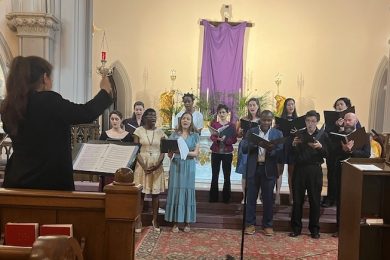
Capitol Hill prayer service ties together mental health and faith

US Catholic pastoral leaders welcome Vatican document on human dignity
- Faith in the Public Arena
- From the Editor

Ask Father Tom: Living the Dream

See you in the story

Easter gives us reason to hope
- Ask Father Tom
- Food for the Journey | Fr. Ron Rolheiser
- Igniting our Faith | Bishop Robert Barron
- In Light of Faith
- In the know with Father Joe
- Marriage Matters
- Parenting Journey
- Question Corner | Fr. Kenneth Doyle
- Sunday Scripture Readings
- Thanksgiving
- Theology 101

Explainer: What are indulgences?

Entering into a ‘Dialogue’ with the loving and merciful Lord

OSV Kids April 2024
- Book Reviews
- Movie Reviews
- Video Game Reviews

The reconstruction of Notre Dame is a symbol of hope

Artist Daniel Mitsui: A portfolio that balances tradition with innovation

Eclipse seen as a way to pray, ‘engage with the work of God’s hands’
- Catholic Social Teaching
- Eucharistic Revival
- Bishop Kettler's Pastoral Letter
- El Visitante
- Laudato Si Study Session
- Melrose Church Fire
- Pastoral Planning
- Safe Environment Articles
- The 7 Sacraments
- YAYA Awards

6 things you need to know about the second round of Synod listening

Father Ron Rolheiser: Reindeer Games

Photos of the week Feb. 23, 2024
Líderes pastorales de ee.uu. aplauden el documento del vaticano sobre la dignidad humana.

El Vaticano ublicará documento sobre la dignidad humana el 8 de abril

Comunidad católica se reúne en oración y ofrece apoyo a afectados por derrumbe del puente
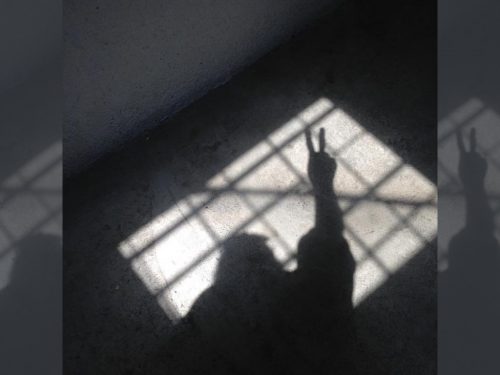
- Special Sections
- Year of Mercy
- YOM Online Lessons
Visit the Imprisoned
Online Lesson: These online lessons may be used: • by individuals anytime, anywhere. • in group settings — families, faith sharing groups, faith formation programs, and schools. • in “flipped” classroom situations for people to view before meeting face to face. You may just want to use a suggested video, story, or question — in anyway that helps us recognize that God’s mercy is anytime, anywhere, and we are called to be merciful as well. The structure of the lesson is based on Msgr. Francis Kelly’s Ecclesial Method .
Step 1 – Preparation: Each lesson will begin with a video and prayer to help us focus on the Works of Mercy in General.
Works of Mercy Reflection:
Merciful God,
You have created us to love You with all our heart, with all our soul, and with all our mind and to love our neighbor as ourselves . Yet we are often imprisoned in some way that prevents us from being as loving as we should be. Keep us mindful of those of us who are imprisoned physically, spiritually and psychologically. Give us the strength to reach out to those who are shackled in some way, and the courage to be open to those who call us to a freedom from our own bonds.
Step 2 – Proclamation: Each lesson will repeat the Works of Mercy to help us remember them.
The Spiritual Works of Mercy :
The Spiritual Works of mercy are acts of compassion, as listed below, by which we help our neighbors with their emotional and spiritual needs.
Counsel the doubtful Instruct the ignorant Admonish sinners Comfort the afflicted Forgive all offenses/injury Bear wrongs patiently Pray for the living and the dead
The Corporal Works of Mercy :
The Corporal Works of mercy are these kind acts by which we help our neighbors with their material and physical needs.
Shelter the homeless/Welcome the stranger Feed the hungry Give drink to the thirsty Clothe the naked Visit the sick Visit the imprisoned Bury the dead
Step 3 – Explanation: This step will address a specific Work of Mercy.
This Month: Visit the Imprisoned
All of the Works of Mercy boil down to this: “Beloved, if God so loved us, we also must love one another. (1 Jn 4:11)”
The Works of Mercy provide ways in which we can love better. The common theme throughout them is the continuance of our journey from self-centeredness to other-centeredness. The Reign of God is made more present as we are more attentive to others in their needs.
Visiting the Literally Imprisoned
Visiting the Imprisoned is a very challenging work in our culture. Below we will explore imprisonment metaphorically, but literal imprisonment deserves attention as well. In his blog, As I See It , Msgr. Vincent Rush posts:
This Holy Work has changed its meaning over time. The first Christians were, as you know, outlaws; so it was expected that some of their number would be in prison at any given time. Jesus was a prisoner; Paul was; Peter was; and many of the saints, bishops, and teachers of the first few centuries of Christian life were. So free Christians took it upon themselves to visit their friends, bringing food, solace, encouragement, and when possible liberation. They also sought the prisoners’ blessing, since to be imprisoned for being a Christian was a mark of great courage and faith. These days things are different, at least in our part of the world. (Christians continue to be imprisoned and even executed for their faith in the Middle East, in China, in Pakistan, in North Korea and in other countries.) People in prison are there as the result of a judgment by a criminal-justice system that, while by no means perfect, does make them different from the Christian prisoners of Jesus’ day. And modern prisons are not, by and large, visit-able places. So how are we to understand this Holy Work today? We might start by remembering that even the prisoner guilty of the most awful crime is still created in God’s image and is loved by God no less than God loves you or me. -Fr. Vincent Rush The Corporal Works of Mercy (4): To Visit the Imprisoned
Nothing helps us understand someone else better than a story. Karen Imholte shares a little of her story as an educator in the prison system, and a little bit of a story of one of her students. With a little tough love, Karen (and his Grandmother) empowered him to take a college level course that changed his life.
Along with the protection of society from truly dangerous individuals, one goal of imprisonment should always be rehabilitation so that the “lost” can be “found” and restored to a right relationship with God and others. But this costs money – for addiction treatment, for education, and for other aids to rehabilitation that are too-easily disposed of in times of budget cuts. And these programs do serve both society and prisoners – a recent study from California showed that both incarceration rates and crime dropped as rehabilitation increased. [1] -Fr. Vincent Rush The Corporal Works of Mercy (4): To Visit the Imprisoned
We are all victims of the deeds of criminals, even if it is just the climate of fear we experience when humans are violated. But how are we engaged with initiatives that make crime less likely to happen? This is a case where we cannot really change anyone but ourselves. How do we change ourselves and our system to affect positive change in others? Can we, in a sense, walk with ‘criminals’ by being proactively engaged in activities that prevent their crimes from ever happening in the first place?
Educating ourselves about the facts of imprisonment in the U.S. is a good step. Again from Fr. Vin:
The population of state and federal prisons grew by over 600% between 1972 and 1998; We imprison only a slightly lower proportion of our population than Russia, which has the highest rate in the world (we’re #2); Half of all inmates are African-American; one out of every three young African-American males is in prison, on probation, or on parole; Between 1970 and 1996 the number of women in U.S. prisons grew from about 5,600 to almost 75,000, a thirteenfold increase; most of these women were arrested for nonviolent crimes. [2] The U.S. bishops have called for reform. Their analysis and proposals are available on the web [note: their section on mission is digested below] . [3] We have to be careful not to allow our thinking about prison and prisoners (when we think about them at all) to be influenced by scaremongering to win votes (a not-unknown political phenomenon). -Fr. Vincent Rush The Corporal Works of Mercy (4): To Visit the Imprisoned
The analysis and proposals of the U.S. Bishops includes a section on the mission of the Church. How are we sent forth to address and act on this issue? Here is an encapsulation:
1. Teach right from wrong, respect for life and the law, forgiveness and mercy
“. … Catholic institutions that offer programs for youth and young adult ministry—including Catholic schools, Catholic Charities, and St. Vincent De Paul agencies—are bulwarks against crime, by providing formation for young people, enrichment and training for parents, counseling and alternatives for troubled children and families, and rehabilitative services for former inmates. ”
2. Stand with victims and their families
“. …Pastors and parish ministers must be prepared to respond quickly and effectively.
3. Reach out to offenders and their families, advocate for more treatment, and provide for the pastoral needs of all involved
“. … We know that faith has a transforming effect on all our lives. Therefore, rehabilitation and restoration must include the spiritual dimension of healing and hope. ”
4. Build community
“. … The Catholic Campaign for Human Development supports many creative efforts to prevent crime and rebuild community. ”
5. Advocate policies that help reduce violence, protect the innocent, involve the victims, and offer real alternatives to crime
“. … We must advocate on behalf of those most vulnerable to crime (the young and the elderly), ensure community safety, and attack the leading contributors to crime, which include the breakdown of family life, poverty, the proliferation of handguns, drug and alcohol addiction, and the pervasive culture of violence.”
6. Organize diocesan and state consultations
“. … We encourage diocesan leaders to convene similar processes of engagement and dialogue with those involved in the system: crime victims, former inmates, jail chaplains, judges, police officers, community leaders, prosecutors, families of victims and offenders, and others.”
7. Work for new approaches
“. … We also hope many others will join with them in efforts to prevent crime, reach out to victims, offer ministry and rehabilitation in our prisons, help to re-integrate ex-offenders, and advocate for new approaches.”
Visiting the Metaphorically Imprisoned
Fr. Vin concludes:
We can also extend the meaning of the Holy Work to consider those who are imprisoned metaphorically in other places: the elderly isolated in nursing-homes (or their own homes); people imprisoned by their addictions or their fears or their ignorance; people imprisoned by others’ views of them (immigrants, non-English speakers, people with disabilities…) The Holy Work of visiting the imprisoned can be as simple as a welcome that breaks down the wall of mistrust. That, each of us has opportunities to do every day. Until next week, peace Fr. Vin Rush Pastor’s Parish Blog “ As I See It “
Although the concept of using “visiting the imprisoned” as a metaphor is probably more comfortable to many of us than the issue literally taken, the challenges are formidable indeed. It is as simple… and as deep and demanding… as love. It is about making present the Reign of God that Jesus proclaimed. And he knew what it took.
Step 4 – Application and Appropriation into Life is the bridge between head knowledge and daily living as a disciple of Christ.
Faith in Action:
How do we reflect God’s love to those in prison? One formal initiative taken on locally is the Central Minnesota Residents Encounter Christ (REC) effort. It is a three part retreat over two days that invites participants to die with Christ, rise with Christ, and go forth to spread the Good News.
Reflection Questions:
Have you, or someone you know, ever spent time in prison? What did “visiting the imprisoned” mean at that time?
List some ways people are metaphorically imprisoned. What does “visiting the imprisoned” mean in those cases?
What are proactive ways we can change ourselves, and therefore our society, to prevent imprisonment from happening?
Suggested Activities (add your suggestions below):
- Call your local jail/prison to ask if it is appropriate to donate some Bibles to inmates. Ask about creating bookmarks with verses of encouragement.
Parish and School:
- Study statistics about the relationship between poverty and both literal and metaphorical imprisonment. Pray specifically for the imprisoned and their families as your students work on your next clothing, food or toy drive.
Step 5 – Celebration: Lessons will close with a prayer, silent or communally, that gives glory to God.
Closing Prayer:
Tender God,
You have created all of us in Your image, even those who are at the margins of society. Give us Your Spirit of Love that, as a Communion, we will create a culture in which no one would choose a path leading to imprisonment. Give us Your Spirit of Courage to find ways of walking with others, even outside of our comfort zones. Remind us that, in helping to make Your kingdom present, we must attend to those who are vulnerable in many ways as we pray the words Your Son gave to us:
Our Father, who art in heaven, hallowed be Thy name; Thy kingdom come; Thy will be done on earth as it is in heaven. Give us this day our daily bread;
and forgive us our trespasses as we forgive those who trespass against us;
and lead us not into temptation, but deliver us from evil. Amen.
In the “Leave a Reply” area below, please suggest another activity people could do to address this Work of Mercy , share a story about someone who visits the imprisoned, or write your own prayer for people in such need.
Author: Kristi Anderson
Kristi Anderson is the editor of The Central Minnesota Catholic Magazine for the Diocese of St. Cloud.
Leave a Reply Cancel reply
Save my name, email, and website in this browser for the next time I comment.
- PRO Courses Guides New Tech Help Pro Expert Videos About wikiHow Pro Upgrade Sign In
- EDIT Edit this Article
- EXPLORE Tech Help Pro About Us Random Article Quizzes Request a New Article Community Dashboard This Or That Game Popular Categories Arts and Entertainment Artwork Books Movies Computers and Electronics Computers Phone Skills Technology Hacks Health Men's Health Mental Health Women's Health Relationships Dating Love Relationship Issues Hobbies and Crafts Crafts Drawing Games Education & Communication Communication Skills Personal Development Studying Personal Care and Style Fashion Hair Care Personal Hygiene Youth Personal Care School Stuff Dating All Categories Arts and Entertainment Finance and Business Home and Garden Relationship Quizzes Cars & Other Vehicles Food and Entertaining Personal Care and Style Sports and Fitness Computers and Electronics Health Pets and Animals Travel Education & Communication Hobbies and Crafts Philosophy and Religion Work World Family Life Holidays and Traditions Relationships Youth
- Browse Articles
- Learn Something New
- Quizzes Hot
- This Or That Game New
- Train Your Brain
- Explore More
- Support wikiHow
- About wikiHow
- Log in / Sign up
- Finance and Business
- Legal Matters
- Law Enforcement
- Imprisonment
How to Visit Someone in Prison
Last Updated: February 8, 2021 Approved
This article was co-authored by Clinton M. Sandvick, JD, PhD . Clinton M. Sandvick worked as a civil litigator in California for over 7 years. He received his JD from the University of Wisconsin-Madison in 1998 and his PhD in American History from the University of Oregon in 2013. wikiHow marks an article as reader-approved once it receives enough positive feedback. In this case, 94% of readers who voted found the article helpful, earning it our reader-approved status. This article has been viewed 72,215 times.
Visiting someone in prison requires some planning on your part. Once you know which prison the inmate is staying at, you need to make sure that you have been put on the inmate’s visiting list. This may require a letter to the inmate. On the day that you are scheduled to visit, you must be sure to dress appropriately and avoid bringing in any prohibited items. Prisons encourage visitation, and once you understand the ground rules then visitation should go smoothly.
Preparing to Visit

- In the United States, you can find a prisoner in the federal system by visiting the Federal Bureau of Prisons and entering the prisoner’s Inmate Register Number. [2] X Research source
- In England and Wales, you can find a prisoner by visiting https://www.gov.uk/find-prisoner . There is an email and fax number provided for you to contact.

- how to get put on the prisoner’s visitation list
- what identification you need
- what items are prohibited from being brought into the prison
- any dress code

- Most prisons ask prisoners to create a visiting list. The inmate then lists family members, friends, and professionals (like attorneys or parole advisors) on the list. [3] X Research source
- You need to be added to the list before you can visit. In order to ask the inmate to put you on, you will probably need to write a letter and ask to be put on. You should also include relevant information that the inmate might need, such as your full name, address, and phone number. [4] X Research source

- Sometimes these applications will be sent to you before you arrive at the prison, and in some prisons you will fill them out as you wait to be admitted.
Visiting the Prison

- revealing shorts or miniskirts
- halter tops, see-through garments, and belly shirts
- low cut blouses, sleeveless shirts, or dresses with slits up the side, front, or back
- baseball hats
- military fatigues or other clothing that looks like inmate clothing

- your identification
- single car key
- bills or change to use with the vending machine
- a bottle and diaper for a baby

- Check with the prison before showing up for visitation. You want to make sure that you have an acceptable form of identification.

- You may be limited in the amount of touching allowed. Prisons may allow hugs, handshakes, and kisses at the beginning and end of the visit. Otherwise, the guards stationed during visitation may limit touching so that visitors aren’t smuggling contraband to prisoners.
- If a guard tells you to stop touching, then you should comply with the order. You may be removed from the visitation if you fail to comply.
Expert Q&A
- Prisons might have different rules for minors. For example, minors under a certain age may not be able to visit without an adult present. If someone under 18 wants to visit the prison, then you certainly need to call ahead and ask if there are special procedures for minors. Thanks Helpful 2 Not Helpful 0

You Might Also Like

- ↑ https://www2.illinois.gov/idoc/offender/pages/inmatesearch.aspx
- ↑ https://www.bop.gov/inmates/visiting.jsp
- ↑ http://www.prisonpro.com/content/visiting-inmate-answers-common-questions-things-you-should-know
About This Article

Visiting someone in prison can be stressful and emotional, but knowing the rules and regulations before your visit will make things easier. Since rules vary from prison to prison, it’s best to check their website or call them for details about what to do. Usually, the prisoner will need to put you on their visiting list and you’ll need to fill out an application when you get there. Since prisons can sometimes get locked down, it’s a good idea to call ahead to make sure visiting hours are still open. Try to arrive 20 minutes early so you have time to park and go through security, and remember to bring your ID with you. For more tips from our Legal co-author, including how to find out which prison a person is held at, read on. Did this summary help you? Yes No
- Send fan mail to authors
Reader Success Stories
M. Hodkinson
Feb 10, 2019
Did this article help you?

Windy Hudgins
Feb 12, 2017

Featured Articles

Trending Articles

Watch Articles

- Terms of Use
- Privacy Policy
- Do Not Sell or Share My Info
- Not Selling Info
wikiHow Tech Help Pro:
Develop the tech skills you need for work and life
EWTN News, Inc. is the world’s largest Catholic news organization, comprised of television, radio, print and digital media outlets, dedicated to reporting the truth in light of the Gospel and the Catholic Church.
- National Catholic Register
- News Agencies
- Catholic News Agency
- CNA Deutsch
- ACI Afrique
- ACI Digital
- Digital Media
- ChurchPOP Español
- ChurchPOP Italiano
- ChurchPOP Português
- EWTN News Indepth
- EWTN News Nightly
- EWTN Noticias
- EWTN Pro-life Weekly
- Register Radio
Get HALF OFF the Register!
National Catholic Register News https://www.ncregister.com/blog/visiting-the-imprisoned-is-a-corporal-work-of-mercy
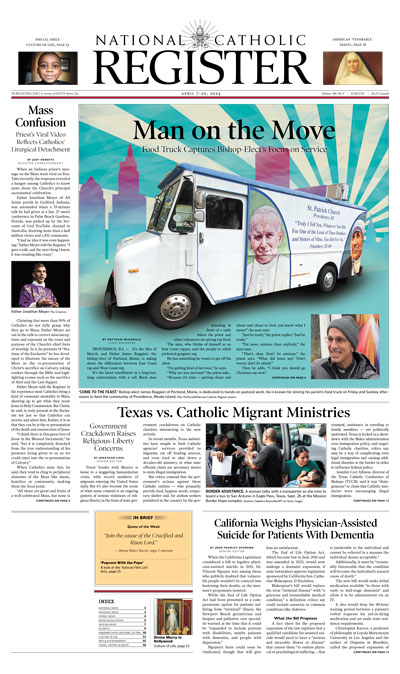
- Synod on Synodality
- Most Popular
- Publisher’s Note
- College Guide
- Commentaries
- Culture of Life
- Arts & Entertainment
- Publisher's Note
- Letters to the Editor
- Support the Register
- Print subscriptions
- E-Newsletter Sign-up
- EWTN Religious Catalogue
Visiting the Imprisoned is a Corporal Work of Mercy
‘For I was hungry and you gave me food ... in prison and you visited me.” (Matthew 25:35-36)

The United States, per capita, has the world’s largest prison population. About 2.3 million people are housed in various detention facilities, with another 5 million on probation or parole. Americans make up around 5 percent of the world’s population, yet house nearly 25 percent of the world’s prisoners.
The Catholic Church has always acknowledged the appropriateness of punishing individuals justly convicted of crimes by the State. In his 1995 encyclical Evangelium Vitae , for example, Pope John Paul II states that the primary purpose of punishment of criminals is “to redress the disorder caused by the offense.” (56)
Yet punishment should also be coupled with humane treatment and compassion and charity toward those imprisoned. The Catechism of the Catholic Church lists visiting the imprisoned as a corporal (bodily) work of mercy (2447), echoing the words of Christ as He foretells His praise of the just on the Last Day: “I was … in prison and you visited me.” (Matthew 25:36).
Without discounting the least the suffering offenders have caused their victims or the appropriateness of their punishment, committed Catholics have been moved by the suffering of the incarcerated, and reached out to help them. Pope Francis, for example, has repeatedly highlighted detention ministry throughout his pontificate.
Prisons a bustle of religious activity
According to a 2012 Pew Forum Survey of U.S. prison chaplains, prisons are a “bustle of religious activity.” Seventy-four percent say attempts by inmates to convert or proselytize other inmates are very or somewhat common. The inmate evangelist/proselytizers are most often Protestant, but an increasing number are Muslim, say the chaplains.
While most thought the number of Catholics in prison was stable, only 13 percent of the chaplains identified themselves as Catholic and the most commonly mentioned Christian group with too few volunteers was Catholics.
I spoke with a priest, deacon and layman who each worked for a long time as a volunteer with detention ministry about their experience.
Deacon Peter Brause, who was previously with the Archdiocese of Los Angeles, volunteered at the California Institution for Men in Chino, California. He assisted with Mass and prepared inmates to receive the sacraments.
He liked working with the inmates and was impressed by their efforts to return to the Faith they may have lost many years before. He said, “The men I work with have made mistakes, but regret them and are trying to find their way back to God … in fact, I have found Jesus to be more present in the Chino facility than in my own parish.”
Many face criticisms from fellow inmates, Brause said, who harbor “an anti-Catholic and anti-Christian bias.” He continued, “It says something about them that they show up for Mass.”
Brause recruited a friend, layman Rob Auten, to lead a catechism class with the inmates. Auten noted that his students had many questions about the Catholic Faith, especially in regard to Protestant critics who challenge Catholic teaching. Protestant volunteers are more numerous than Catholics, he observed, and some attack Catholicism. Auten is able to help the inmates with the knowledge they need to respond to such critics.
Like Brause, Auten has found prison ministry rewarding. He said, “I love teaching the Faith, and the men seem to really appreciate it.”
Auten admitted that there are some days he’d rather not go to the prison, but once he’s gone, he’s always glad he did. He said, “It’s very rewarding. The men are always so glad to see us. They appreciate what we do.”
“Common sense” rules
Volunteering in a prison is not like volunteering at one’s parish, they noted. Prisons have a variety of “common sense” rules volunteers must follow. Socializing and undue familiarity, such as hugging, is prohibited. When inmates go on probation, volunteers are not allowed to contact them.
Cell phones are prohibited. Only a small amount of wine is consecrated at Mass, and inmates are not allowed to drink from the chalice.
And, most importantly, volunteers must always follow the directions of the prison staff and be prepared for interruptions in their ministry. On his first-ever visit to the prison, for example, Brause recalled that as he was preparing to enter the facility, an alarm went off due to an inmate fight inside the facility. Brause had to wait an hour until the alarm was over and he could begin his ministry.
Fr. Harold Paulsen (1931-2016), who was a priest of the Diocese of Tyler, Texas, worked in prison ministry for more than 20 years. He lamented that those in elected office who oversee prisons “run for office on security.” He continued, “’Security’ is the magic word; keep those who commit crime locked up so they don’t bother anyone. The problem is, when inmates do get out, they’re worse people than when they went in.”
In his retirement, Fr. Paulsen visited five Texas prisons. He was the author of multiple books, including When I Was in Prison – Hope for the Hopeless, which offers help to the imprisoned and shares with the outside world what prison life is like. The purpose of his ministry, he said, “is to get inmates to be better men than when they went in. I tell them the best thing they can do for their families is to become a better person, which they can do with Christ.”
Their encounter with Christ at his weekly Masses is essential, he found. He said, “It’s so important. I’ve had inmates tell me they live from Mass to Mass.”
Prison life can be dangerous, lonely and humiliating. Additionally, one is surrounded by bad influences, making rehabilitation difficult. Violence, too, is commonplace: “Inmates have to fight, whether or not they win. It’s the rule of life. They have to fight, or it will be open season on them.”
He recalled a conversation with a 20-year inmate. The man told him, “I’ve had a lot of fights, and a perfect record. I’ve never won one.”
Father lived in the “Bible Belt,” where Catholics make up 3 percent of the population, and anti-Catholicism is common. Some of the greatest resistance to his work, he noted, was from some of the Protestant chaplains who work at the prisons. He didn’t mind fighting for the Faith, though: “I like it. It’s a challenge.”
He pleaded with the public for patience and understanding of the prison population, invited their prayers and support, and reminded them that all inmates are not “bad apples.” He concluded, “There are good people in prison who want a good life. They don’t want to return to crime.”
Upon Fr. Paulsen’s death in 2016, Bishop of Tyler Joseph Strickland said, “Father Paulsen had a special love for the poor, the hurting and the incarcerated members of the Body of Christ and dedicated his life, especially his later years, to helping those in special need of the Church’s pastoral care. He was truly a missionary of mercy who brought the love of Christ to those in most need of compassion and forgiveness.”

Jim Graves Jim Graves is a Catholic writer and editor living in Newport Beach, California. He previously served as Managing Editor for the Diocese of Orange Bulletin, the official newspaper of the Diocese of Orange, California. His work has appeared in the National Catholic Register, Our Sunday Visitor, Cal Catholic Daily and Catholic World Report.
- Related Stories
- Latest News

Four Lingering Questions After ‘Dignitas Infinita’
The new declaration on human dignity has been well received, but its impact on topics like the Synod on Synodality and the Church’s pastoral response to gender theory remains to be seen.

Abortion Amendment Disqualified from Maine 2024 Election Ballot
According to the Maine Division of Public Health Systems’ most recent data, there were 2,225 abortions in the state in 2022, up from 1,915 in 2021.

‘The Lord Has Risen Indeed!’
User’s Guide to the Third Sunday of Easter

Puberty Blockers May Cause Irreversible Harm to Young Boys, Mayo Clinic Study Finds
The study included 87 children total, with 16 boys who identified as girls and nine of whom took puberty blockers.

‘Irena’s Vow’ — Faith and Courage at the Crossroads
This is the story of a heroine who believes that every choice we make for good or evil matters to God and to his plan.

Totality or Nothing: What the Solar Eclipse Revealed About God
God simply never tires of ways of delighting us.

Heavenly Drama Unfolds: Solar Eclipse Marks Annunciation With Divine Beauty
A solar event on the solemnity: Catholic minds offer their best takes on what was witnessed from celestial skies above ...
Which Mary Should Catholic Women Follow?
A voice unheard: the absence of deacons at the synod, photos: foundation releases never-before-seen images of padre pio, bishop-elect dies within days of his episcopal consecration, trump says he will not sign a national abortion ban if reelected, pope francis: ‘a christian without courage’ is ‘a useless christian’, trump’s big abortion announcement is a big disappointment, new idaho law aims to protect against forced use of incorrect pronouns, names, subscription options.

Subscriber Service Center Already a subscriber? Renew or manage your subscription here .
Subscribe and Save HALF OFF! Start your Register subscription today.
Give a Gift Subscription Bless friends, family or clergy with a gift of the Register.
Order Bulk Subscriptions Get a discount on 6 or more copies sent to your parish, organization or school.
Sign-up for E-Newsletter Get Register Updates sent daily or weeklyto your inbox.
Official websites use .gov
A .gov website belongs to an official government organization in the United States.
Secure .gov websites use HTTPS
A lock ( Lock A locked padlock ) or https:// means you've safely connected to the .gov website. Share sensitive information only on official, secure websites.
Federal Bureau of Prisons
General visiting information.
Make sure your visit will be a success by carefully following these four steps.
Discover or confirm the whereabouts of the inmate you would like to visit.
Before you can visit you must be placed on the inmate's approved visiting list.
Review all visiting rules, regulations, and procedures before your visit.
Find out when you can visit and get directions to the facility.
Locate the inmate
Sometimes an inmate may be moved to a different facility so that they can benefit from unique programs offered at that location. They might also be moved to receive treatment for a medical condition or for security concerns. Therefore, the first step in planning your visit should be to determine where the inmate is currently housed.
Please verify you are a human by entering the words you see in the textbox below.
To visit, you must be pre-approved.
You can only visit an inmate if they have placed you on their visiting list and you have been cleared by the BOP.
- An inmate is given a Visitor Information Form when he/she arrives at a new facility.
- Inmate completes their portion of the form and mails a copy to each potential visitor.
- Potential visitor completes all remaining form fields.
- Potential visitor sends the completed form back to the inmate's address (listed on the form).
- We may request more background information and possibly contact other law enforcement agencies or the NCIC
- The inmate is told when a person is not approved to visit and it is the inmate's responsibility to notify that person.
Who can an inmate add to their visiting list?
- Step-parent(s)
- Foster parent(s)
- Grandparents
- No more than 10 friends/associates
- Foreign officials
- Members of religious groups including clergy
- Members of civic groups
- Employers (former or prospective)
- Parole advisors
In certain circumstances such as when an inmate first enters prison or is transferred to a new prison, a visiting list might not exist yet. In this case, immediate family members who can be verified by the information contained in the inmate's Pre-Sentence Report, may be allowed to visit. However, if there is little or no information available about a person, visiting may be denied. You should always call the prison ahead of time to ensure your visit will be permitted.
Be Prepared
You should be familiar with all visiting rules, regulations, and procedures before your visit.
The following clothing items are generally not permitted but please consult the visiting policy for the specific facility as to what attire and items are permitted in the visiting room:
- revealing shorts
- halter tops
- bathing suits
- see-through garments of any type
- low-cut blouses or dresses
- backless tops
- hats or caps
- sleeveless garments
- skirts two inches or more above the knee
- dresses or skirts with a high-cut split in the back, front, or side
- clothing that looks like inmate clothing (khaki or green military-type clothing)
Plan your trip
- the prison location
- the prison type
- inmate visiting needs
- availability of visiting space
The inmate you plan to visit should tell you what the visiting schedule is for that prison; however, if you have any questions please contact that particular facility .
General Visiting Hours
Camp general visiting hours, fsl general visiting hours.


Sixth corporal work of mercy: Visiting the imprisoned
God calls the faithful to show mercy to those physically, mentally in prison.
By Marge Fenelon Catholic News Service
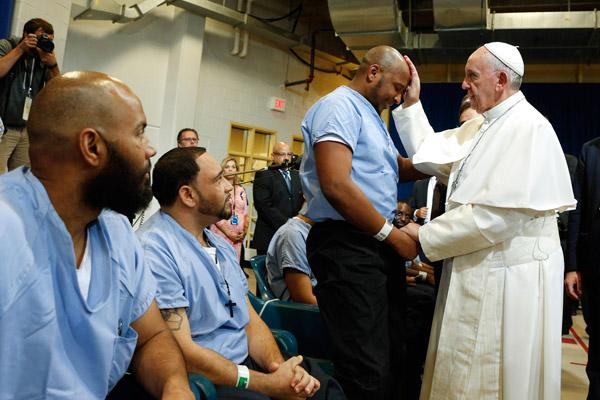
During this Year of Mercy instituted by Pope Francis, we’re called to become extensions of God’s mercy to others, particularly through the spiritual and corporal works of mercy — acts of charity and love toward others.
But one corporal work of mercy may prove a bit more challenging to carry out — visiting the imprisoned. How are we supposed to visit the imprisoned?
No doubt, it’s important to visit prisoners. They need and deserve Christian love and charity as much as anyone else. But there are different ways to be imprisoned. Just as there are physical bars that keep us locked in, there are mental, emotional and spiritual walls that keep us locked in as well.
Fears, anxiety, depression and hopelessness are all “prisons” that hold us captive, keeping us from feeling the love of God. They cage us in, stopping us from becoming children of God and from becoming the person he intended us to be. We may not have committed a crime per se, but we are incarcerated just the same.
Our Lord had compassion for those imprisoned by invisible walls as well as those imprisoned by real walls. There are numerous examples in Scripture, but the one that comes to mind is the story of the Gerasene demoniac (Mark 5:1-20) cured of his affliction and released from his cell by Jesus.
Jesus and his disciples had crossed the Sea of Galilee and entered Gerasa. There, he found a man who had long been tormented by demons and lived among the tombs. No manner of restraint could keep him from causing harm to himself or to others. The people of Gerasa feared him.
Amid the man’s shrieks, Jesus commanded the demons to leave him. At their request, Jesus sent the demons into a nearby swineherd. The swine then ran to the edge of a high cliff and jumped off, falling into the water and drowning. Only then, the man was again in his right mind and made capable of living a normal, productive life.
The Gerasene man had been imprisoned by demons, kept in a jail of torment that prohibited him from living a life of love and fruitfulness with family and friends. Jesus visited him in this prison, so to speak, by seeing him, not as he was, but as he could and should be: a free and joyful child of God.
So, too, should we see and help those who are imprisoned by a variety of walls. We should see them, not as they are, but for what they should and can be: free and joyful children of God. They need us to visit them in their prisons and to minister to them with compassion.
We may not be able to cure them of their torment, as Jesus did with the Gerasene man, but we can be for them a reflection of the light in their darkness.
Please read our Comments Policy before posting.

Related Articles
Current news, news & views from you, from the bishop.
Join Us on Facebook | Follow Us on Twitter | Privacy and Terms of Use | View and Buy Photos | Advertise | About Us
© 2024 Arkansas Catholic | 2500 N. Tyler St., Little Rock, AR 72207 | (501) 664-0125
- CM Hangouts
- Explore all stories
- Daily Prayers
- Sunday Gospel Activities
To Visit the Imprisoned
Sep 26, 2016 12:00:39 PM | by Roxane Salonen
It's a corporal work of mercy that, so often in my life, I've opted to sort of skirt around. I'm a mother, after all, and this means vigilance when it comes to my family. And so the thought of visiting the imprisoned has seemed something to avoid.
And yet, lately, God has very directly been tapping me. "Don't be so quick to bypass this one," I hear him saying.
So many things have gone into play which bear reflection and discernment. It started with a local woman who is passionate about a ministry our county has adapted called Jail Chaplains. My sister also has been involved in a similar ministry in her city in the central part of the state.
And then came the Jubilee Year of Mercy. While giving a talk on mercy, I welcomed comments from a priest, who shared about his involvement in Jail Chaplains. He spoke with such conviction that my heart began to expand, and wonder what my role could be.
Then, recently, I heard that our bishop offered Mass at our jail, and our parish put out a bulletin call for spiritual books that could be brought to the inmates. I also have learned that weekly Eucharist services are going to be added for both men and women behind bars in our city.
Each time I hear about the need for the imprisoned to be ministered to, I feel less inclined to run the other way. Though cautious still, I am at least open to the possibilities.
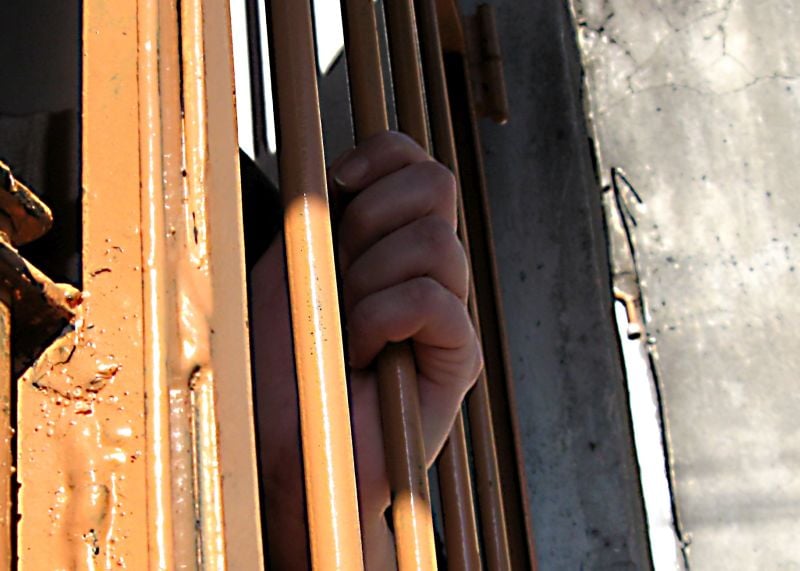
Recently, I had a chance to follow through on a Holy Spirit nudge when I was invited to have lunch at our county jail. We would hear a presentation about Jail Chaplains, eat the same lunch the inmates would be served, and listen to testimonies of former and current inmates, as well as one of the leaders of the program.
It was a step I'm grateful to have taken. Just being on the premise opened my eyes, and so many thoughts began stirring. Certainly, I felt more connected to those who reside within the concrete walls of the jail as I nibbled on a very basic sandwich and slurped down corn chowder, drinking water from a Styrofoam cup.
The former and current inmates who talked with us shared a little of their life stories. Both had been introduced to Christ early in their lives, but for whatever reason, it didn't stick, as with so many young people. Each, for fairly valid reasons, became disillusioned with life, and in time, turned to a life of crime, mostly entwined with drugs.
Addiction cannot be taken out of the equation. A large majority of the incarcerated are addicts, and as we know, addiction follows other ills in one's life, not because those individuals really enjoy the taste of their drug of choice.
I found the insight of the current inmate, who came into the room in his bright-orange garb, to be particularly revealing. Before he connected with Jail Chaplains, he said, time in jail was just a pause from one high to another; just a stall. He showed up at one of the Jail Chaplains meetings because of a promise of food. But something there grabbed him, something hopeful. And after a while, he says, he began "looking at people differently," noticing things around him he hadn't seen before. It was as if his frozen soul had begun to melt. Drop by drop, something new came into view. Now, seeing college on the horizon, he is grateful to have Christ back in his life.
By the time he got done talking, I saw him not as another inmate but a boy searching for God, desperate to make a better life for himself. Rather than scary, he seemed vulnerable, and certainly, his willingness to share his story touched me. He'd been a meth baby, so from that start, it seemed, was doomed. But no more.
A sheriff's deputy who has helped with the program shared that since its incorporation, tension within the jail has decreased significantly. For when people begin to understand that they have dignity, the need to fight against the world and everyone in it lessens.
Even as I'm absorbing all of this, I've been poring through Peter Kreeft's newest book, I Burned for Your Peace: Augustine's 'Confessions' Unpacked , which has me enthralled. And I've reached the point at which St. Augustine knows Truth, but is not quite ready to go all the way.
"And here I was going on thirty, still sticking in the same mire, greedy for the enjoyment of things present though they ever eluded me and wasted my soul, and at every moment saying, 'tomorrow I shall find it.'"
Oh, the ever elusive, "I will change...tomorrow."
These thoughts and others kept Augustine restless.
"Time was passing and I delayed to turn to the Lord. From day to day I postponed life in You, but I did not postpone the death that daily I was dying in myself."
But then comes the good news; news that can help us see what might be possible.
"Augustine's dissatisfaction with his own life was a necessary preliminary to his conversion," Kreeft notes. "Someone who is totally satisfied with his life is not going to convert, or marry, or join the army."
I pause, thinking of my illumination that day in the jail. Who is in a better position to hear about Christ than one who, at least for the moment, is clear-headed, with basic needs met, yet haunted by a past that has only led to discord and fragmentation? The incarcerated are perhaps most equipped to sit down and hear the story of a God-man who can make all things new.
[Tweet "Visiting the imprisoned reminds @peacegardenmama to consider how to serve those hungry for God."]
It's taken me a while to get here, but as a friend pointed out when my children were really small, the imprisoned can be the child in the crib, or the mother feeling isolated in her own home while caring for young, needy children. There are times in our life when staying put is the best thing of all -- and sometimes, the only possible thing. But there are other times God asks more of us. He bids us to come more closely into his heart to see more fully the needs around us, and to pray on how we might serve him through serving those hungry for his love.
I don't know for sure how this will end. I'm still praying, still discerning. But I have to admit at the very least that I have been awakened. For how can I, having known the love of God, not want to bring that to others, especially those who have been denied this gift?
"...if we taste one second of contemplative joy, one 'timeless moment,' we cannot forget it," Kreeft says. "Once you have had the tiniest taste of eternity, you cannot be wholly satisfied with any other food. It is a divine gift, an appetizer of Heaven."
Q4U: We cannot all literally visit the imprisoned. But what CAN we do in our current state of life to respond to this corporal act of mercy?
Copyright 2016 Roxane Salonen
Share this article
About the Author

Roxane Salonen
Roxane B. Salonen, Fargo, North Dakota (“You betcha!”), is a wife and mother of a literal, mostly-grown handful, an award-winning children’s author and freelance writer, and a radio host, speaker, and podcaster (“ Matters of Soul Importance ”). Roxane co-authored “ What Would Monica Do? ” to bring hope to those bearing an all-too-common cross. Her diocesan column, “ Sidewalk Stories ,” shares insights from her prolife sidewalk ministry. Visit RoxaneSalonen.com
Related Blog Articles

Subscribe to Catholic Momcast on iTunes or Spotify
Catholicmom on social networks, about catholic mom.
Support CatholicMom.com
Associated Links
Holy Cross Family Ministries
Family Rosary
Family Theater Productions
Congregation of the Holy Cross
Father Patrick Peyton, C.S.C.
CatholicMom.com Book Series at Ave Maria Press The Peyton Institute for Domestic Church Life
Stay connected! Don’t miss a thing! Sign up to receive our free daily digest email.
Copyright © 2024 CatholicMom.com. All Rights Reserved.

- Ministry Resources
Charity, Justice, and Mass Incarceration: How Visiting the Imprisoned Changed Me
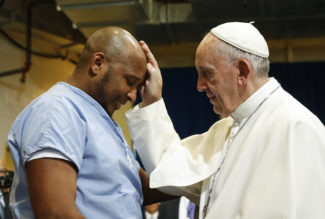
Some things didn’t surprise me during my first visit to a state correctional facility in 2011. When I got involved with Partakers , a College Behind Bars mentoring program that pairs volunteers with incarcerated men and women working on a college degree, the program coordinator gave me plenty of advice: Leave your jewelry at home — you’re not going to like the look of the lockers. Wear a sports bra — the metal detectors are on steroids, and if they go off, you’re going home. And don’t make any plans for the rest of the day — the lines move at a snail’s pace.
Other aspects of my first visit defied expectations. Hollywood had led me to believe that I’d meet Tom, to whom I’d introduced myself via letter, in a visiting booth with a glass partition separating the two of us and that he’d be wearing an orange jumpsuit. Instead, all visitors gathered in a large, open room where we were met by men in blue jeans and white T-shirts. Tom greeted me with a warm, firm handshake, which was another surprise. I didn’t think that physical touch would be permitted, so I didn’t anticipate the messages silently conveyed in Tom’s confident, yet gentle, grip.
Though I don’t recall what exactly I expected of Tom, I clearly remember the sting of self-reproach as I was surprised by his handshake. Shame on me for having preconceived notions about a person I didn’t know merely because he was incarcerated. This was the first of many moments that I was stretched and grew through my relationship with Tom.
RELATED: Comfort the Mourning: 5 Tips for Writing a Meaningful Sympathy Note
Moments of encounter with another can be personally transformative, and that is one of the greatest blessings of putting the Corporal Works of Mercy — seven instructions based on the teachings of Jesus — into action. The works offer a clear path to honoring the dignity of all people, and they open us up to experiencing our shared humanity with our hungry, thirsty, sick, marginalized, vulnerable, and incarcerated brothers and sisters.
Like all the works of mercy, there are many ways to put visiting the imprisoned into action. Here are just a few:
Visit someone in prison
Numerous organizations coordinate relationships between volunteers and people behind bars. Pen America and Prison Fellowship are two examples, but a quick Google search will uncover other nonprofits in your area. Or find out if your church or diocese has a prison ministry . Alternatively, consider your own social networks: Do you know anyone, or do you know anyone who knows anyone, who is in jail or prison? If you worry that your visit may be unwelcome, send a letter of inquiry first.
Become a pen pal
If visiting isn’t possible, consider developing a pen pal relationship. Many people in prison, especially those on death row, have minimal contact with the outside world, and letters provide both longed-for news and human connection. Like visiting, you might start by writing to someone from your social network, or you can use a program like the Death Row Support Project to get connected. Before writing, visit the prison or jail’s website to read their rules and procedures, and also check out Mary Catherine Johnson’s tip sheet for letter writing. Although Johnson writes about her experience corresponding with someone on Georgia’s death row, she includes excellent general advice that is universally helpful.
RELATED: Catholic Social Teaching and Reducing Food Waste
Be part of criminal justice reform
You can also get involved with one of the many nonprofits working to reform our country’s broken criminal justice system through programming and advocacy. This could mean anything from offering financial support to filling numerous volunteer needs to getting the word out about the organization. Maybe you decide to host a book drive at your church for the Prison Book Program , knowing that education is proven to reduce recidivism rates . Or sign up to meet a newly released man or woman at the prison gates through the Ride Home Program with the knowledge that release can be an overwhelming and frightening time for the formerly incarcerated, and that they are at the highest risk for recidivism in their early days of freedom. Or answer hotline calls or fundraise for Freedom for Immigrants , an organization devoted to abolishing immigration detention. Any of these organizations would benefit from your time, talent, treasure, and dedication to honoring the humanity of people behind bars.
I’ve heard it said that charity and justice are the two feet of love in action : Charitable works respond to immediate needs and social justice addresses systemic, root causes of problems. I would contend that charity and justice are the caterpillar and butterfly of living out the Gospel message. Encounter with another through the Corporal Works of Mercy gives birth to personal transformation and a renewed hunger for justice. A desire to live charitably led me to Tom, and in turn, Tom led me to be challenged and changed. While I no longer visit Tom – he graduated from the program, and I moved away – I know that his graduation didn’t lead to his parole. My care for Tom and the 2.2 million others suffering under the weight of mass incarceration impacts my prayers, my decisions in the voting booth, how I talk about people behind bars, and my choices about charitable giving. Our encounter instilled in me a conviction that I must play a part in working for justice for all members of our shared humanity.

Help us share the joy of Christmas all year long!
Help us share the joy of advent and christmas all year long.

DOUBLE YOUR DOLLARS and help us share the joy of Advent and Christmas all year long!

Last chance to help us share faith joyfully in 2023!
Have you joined our mailing list yet.
Sign up for weekly updates from Busted Halo!


Extend Compassion Behind Bars - Connect Through Scripture
Download Bible Chat & Study today.

Bible Verses for Visiting the Imprisoned
When we find ourselves called to minister to those who are incarcerated, it's important to remember that God's Word is our greatest source of guidance and encouragement. In this article, we'll explore key Bible verses that remind us of our responsibility to visit the imprisoned and offer them love, hope, and support. These verses will not only provide you with a deeper understanding of God's heart for the incarcerated but also inspire you to take action.
Matthew 25:36 (H2)
"I was in prison and you came to visit me." - Matthew 25:36
In this passage, Jesus emphasizes the importance of visiting those who are imprisoned. He teaches that when we care for those who are suffering, we are directly serving Him. By visiting the incarcerated, we are fulfilling a crucial aspect of our Christian duty and extending the love of Christ to those who desperately need it.
Hebrews 13:3 (H2)
"Continue to remember those in prison as if you were together with them in prison, and those who are mistreated as if you yourselves were suffering." - Hebrews 13:3
This verse reminds us to empathize with those who are incarcerated and to consider their suffering as if it were our own. By doing so, we not only develop compassion for the imprisoned but also deepen our understanding of their struggles. This empathy compels us to take action and comfort those who are experiencing hardship behind bars.
Proverbs 31:8-9 (H2)
"Speak up for those who cannot speak for themselves, for the rights of all who are destitute. Speak up and judge fairly; defend the rights of the poor and needy." - Proverbs 31:8-9
These verses call us to be advocates for those who are unable to speak for themselves, including the incarcerated. Many prisoners face unjust treatment and are in desperate need of support and advocacy. As Christians, we are called to defend the rights of the poor and needy, ensuring that justice and fairness prevail.
Isaiah 61:1 (H2)
"The Spirit of the Sovereign Lord is on me, because the Lord has anointed me to proclaim good news to the poor. He has sent me to bind up the brokenhearted, to proclaim freedom for the captives and release from darkness for the prisoners." - Isaiah 61:1
As followers of Christ, we are called to share the good news with the poor, the brokenhearted, and the imprisoned. This verse in Isaiah reminds us that God's mission includes bringing freedom and release from darkness to those who are incarcerated. By visiting prisoners and sharing the Gospel with them, we are fulfilling God's purpose and extending His transformative love.
These verses serve as powerful reminders of our calling to visit and care for those who are imprisoned. By doing so, we are fulfilling our Christian duty, demonstrating the love of Christ, and participating in God's mission to bring freedom and hope to the captives. Let these verses inspire you to take action and serve those who are incarcerated, knowing that in doing so, you are serving Christ Himself.
What does the Bible say about visiting the imprisoned?
The Bible emphasizes the importance of visiting and caring for those who are imprisoned. Matthew 25:36, for example, quotes Jesus as saying, 'I was in prison and you came to visit me.' This passage teaches that when we care for those who are suffering, including prisoners, we are directly serving Jesus. By visiting the incarcerated, we are fulfilling a crucial aspect of our Christian duty and extending the love of Christ to those who desperately need it.
How can we develop empathy for those who are incarcerated?
Hebrews 13:3 provides guidance on how to develop empathy for those who are incarcerated: 'Continue to remember those in prison as if you were together with them in prison, and those who are mistreated as if you yourselves were suffering.' By considering the suffering of prisoners as if it were our own, we not only develop compassion for the incarcerated but also deepen our understanding of their struggles. This empathy compels us to take action and comfort those who are experiencing hardship behind bars.
What is our responsibility as Christians towards the incarcerated?
As Christians, we are called to defend the rights of the poor and needy, including those who are incarcerated. Proverbs 31:8-9 urges us to 'speak up for those who cannot speak for themselves, for the rights of all who are destitute. Speak up and judge fairly; defend the rights of the poor and needy.' Many prisoners face unjust treatment and are in desperate need of support and advocacy. We are called to ensure that justice and fairness prevail for these individuals.
What is the significance of Isaiah 61:1 in relation to prisoners?
Isaiah 61:1 highlights the mission of bringing freedom and release from darkness to those who are incarcerated: 'The Spirit of the Sovereign Lord is on me, because the Lord has anointed me to proclaim good news to the poor. He has sent me to bind up the brokenhearted, to proclaim freedom for the captives and release from darkness for the prisoners.' As followers of Christ, we are called to share the good news with the poor, the brokenhearted, and the imprisoned, and to participate in God's mission of extending His transformative love.
How can these Bible verses inspire us to take action?
Download our free app today.
If you want to learn more you can always get answers with our free Bible expert.


To continue reading visit our Bible Chat App
Click on these buttons to close the popup...
Visit the Imprisoned
- skip to main content
- skip to footer
- Immigration
- Nonviolence
- Social Justice Resources
- Our Faith and Values
- Prayers and Meditation
- Spiritual Direction
- Retreat and Spiritual Centers
- Request a Prayer
- Pastoral Services
- Social Services
- Mercy Investment Services
- Ministry Stories
- Mercy Association in Scripture and Theology
- Mercy International Association
- Mercy Locations
- Stories of Mercy
Take Action
- Advocate for Social Justice
- Mercy Volunteer Corps
- Support CCASA
- Ways to Give
- Become a Sister
- Become a Mercy Associate
- Become a Companion in Mercy
- Job Opportunities
In this year’s Lenten reflection series, seven sisters offer their personal stories and insights on each of the Corporal Works of Mercy and how acts of mercy can have a profound impact on the lives of our sisters and brothers. Accompanying these reflections are line drawings by Sister Mary Clare Agnew, a contemporary of Catherine McAuley, which illustrate the Sisters of Mercy in ministry in 1830s Ireland. The reflection series also includes reflections for Ash Wednesday, Palm Sunday, Holy Thursday and Easter.
By Sister Natalie Rossi , Campus ministry, Mercyhurst University , Erie, Pennsylvania ; On staff, State Correctional Facility at Cambridge Springs , Cambridge Springs, Pennsylvania
To find the genuine in oneself is to find God.
Does one find God in prison? One could say one is overwhelmed with the Presence of God in prison.
“We see because we are seen. We love because we are loved.” ( Edward Hahnenberg )
I have worked in prison ministry for about 20 years, not all at one time. The women I see or talk with open their hearts to God. They want to be seen for who they are, a person created by God in God’s image. They have hit bottom and are reaching for something to bring them peace and healing. They are ripe for Jesus.
The hardest part is to help them believe that they are good because God dwells within them. God doesn’t leave them.
When COVID-19 hit, I was fortunate because I am under contract with the diocese to work in the prison and so could continue to go in. Volunteers could not. I offered spirituality and art. But the most important activity that I did was to visit the units and each person.
They wanted to be seen. Just that little visit brought many “thank yous.” Just letting the women know that God loves them brought so much peace.

Currently, in many prisons and jails, volunteers still can’t visit. So where else can we find the imprisoned besides a state women’s prison at Cambridge Springs?
I meet them every day at Mercyhurst University. Students struggling to be OK with themselves—to find meaning in their lives—to believe that they are loved—that God is with them. You are OK because God created you in God’s image—whether a person be straight, LGBTQ+, Black, white, autistic, disabled, etc. We are all one—same DNA—all created by LOVE.
Look around at your neighbors, relatives and friends who struggle to believe in themselves. Many are imprisoned within themselves.
How do we free those who have imprisoned themselves? How do we free ourselves? The answer is love—Luke 6:27-38.
Look around and be aware this Lent. Young persons, the elderly, perhaps, all of us struggle with being accepted for who we are. So many times, persons become who they think people want them to be, and, if not, they believe they are less than.
How do we free ourselves and others from the prisons we have put ourselves in?
“Everything is filled with sacred presence.” (Psalm)
“We are not called by God to do extraordinary things, but to do ordinary things with extraordinary love.” (Jean Vanier)
Inmates are aware that they are imprisoned. This Lent, become aware of how we are imprisoned and of how many who are walking around us are also imprisoned.
This Lent , set aside quiet time to be with God. Or become aware that God is everywhere; so be aware of God in all things, especially the persons with whom you come in contact. Make it a point to greet each person with a smile. Pray especially for people you judge or don’t like. Send God’s love to them. Let God heal…or heal you to accept the person for who they are at this moment. We all possess God.
Pray during this Lent to not judge people and to forgive wrongs that have been done to you. Spend time offering the silence up as a time of love for others. It is easy to give up food for Lent, harder to give up judging and non-forgiving.
This Lent, put more tenderness into the world, and the world we live in will become a more loving place.
Everything is nothing but the expression of God’s exuberance.
The Catholic Diocese of St. Petersburg
Share this story
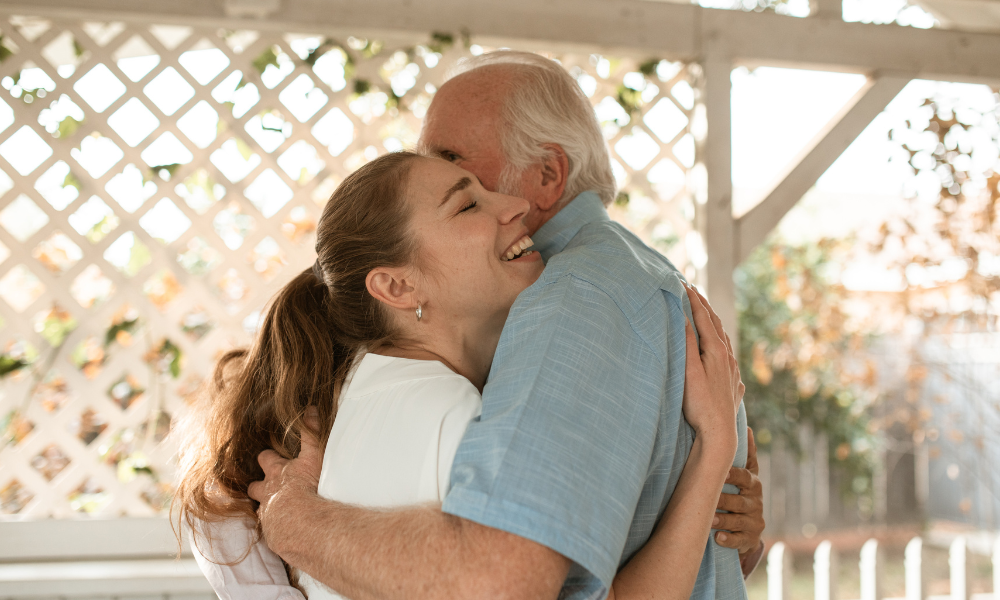
How Can Families Practice the Works of Mercy? - Visit the Imprisoned
March 14, 2023 | “i was hungry and you gave me food, i was thirsty and you gave me drink, a stranger and you welcomed me, naked and you clothed me, ill and you cared for me, in prison and you visited me.”.
Jesus’ powerful words in the Gospel of Matthew form the basis for the traditional list of the works of mercy. When it comes to meeting physical needs, the Compendium to the Catechism of the Catholic Church lists the following actions as the corporal works of mercy:
- Feed the hungry
- Give drink to the thirsty
- Clothe the naked
- Shelter the homeless
- Visit the sick
Visit the imprisoned
- Bury the dead
How can families live this out? Especially with young children, hands-on charitable work can be daunting, but not impossible. The works of mercy will look different for each family – and can be practiced very literally when it comes to caring for children! But if you have a desire to introduce your children to acts of charity outside the home, I hope these ideas can be a gentle nudge to step out as the domestic Church and seek encounters with those in need.
As with “burying the dead,” visiting the imprisoned might seem, at first glance, a work of mercy that’s out of reach for most families. How is that supposed to work with young children?
Let’s back up and think about aspects of our society that can create isolation, loneliness and even a feeling of imprisonment. Even before the COVID-19 pandemic, the “loneliness epidemic” was being acknowledged, and studies continue to confirm its prevalence, including among young adults and parents of young children. We could go on for pages about the causes, but in the end, chances are high that someone near us feels miserably alone – even in the busyness of family life.
I’ve seen this in mothers who love their babies and are grateful to be able to stay home with them, but feel like their only interaction with adults comes through their smartphones. For others, isolation might come in the form of a diagnosis or disability that impedes routines and socializing. When it’s difficult to leave the house or commit to invitations for any reason, loneliness can creep in, and even the most loving home can feel confining. A single parent juggling the roles of two; someone with a spouse on military deployment or working irregular hours – these are situations not uncommon to our experience as families, and they can all contribute to people losing connections and chances for friendship. How can we remain sensitive to these needs? When friends might feel constrained by their current circumstances, are we willing to go to them, and to keep offering our friendship?
And while visiting literally incarcerated people isn’t possible for most families, writing letters is. One place to start would be a diocesan prison ministry, if they’re equipped to set up volunteers with an incarcerated pen pal. Another option is the Order of Malta Pen Pal Program (orderofmaltafederal.org/prison-minsitry), which enrolls volunteers from across the country.
I can understand why some families might hesitate at the thought of involving their children. Is it safe? What would you even write about?
To the first point, I’ll say that every program I’ve encountered takes great pains to protect letter writers’ privacy – and to make sure you know how to maintain an appropriate relationship with your pen pal. As to the second question, I asked a friend who has done this for many years, and she pointed out that many prisoners are estranged from their own families. Having communication coming from the heart of family life can be deeply meaningful.
If you’re looking for a practice to take up this Lent, consider whether writing letters to incarcerated people might be a work of mercy for your family. Regardless of how you practice visiting the imprisoned, may you and your family bring the light of Jesus into some of the dark, lonely corners of your world.
Elizabeth Hansen and her husband, Luke, raise their four children in Lansing, where they attend Resurrection Parish.
Related Stories

Over-protecting or just keeping kids safe?
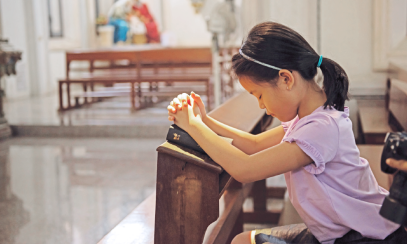
Helping Hesitant Kids Go To Confession

Lovingly establishing boundaries with neighborhood kids
Prison Fellowship
How to Prepare for a Prison Visit
Visiting a family member in prison presents its own bundle of challenges. Just knowing what to expect can reduce stress. Being prepared can raise the bar for positive visitation experiences, possibly snowballing into more visits, and hopefully, improved relationships.
Since studies point to lower recidivism rates for prisoners who stay connected to supportive family members, positive prison visits end up benefiting everyone: prisoners, families, and the community. For the 1.5 million children and youth who have at least one incarcerated parent, visiting their parent(s) can strengthen family bonds.
To be prepared, consider the following information the first time visiting someone in prison. Please keep in mind that rules vary among prisons.
BEFORE VISITING PRISON
Be approved.
Be sure your name is on the prisoner's pre-approved visiting list for people age 18 and older. Information on the form allows officials to do background checks to approve or deny visitation. Most facilities require this form, but verify with the facility to be sure. Some facilities also require an authorization form for children.
Check the facility's visitation hours, which are typically weekends and holidays, and possibly additional days depending on the facility and security level. Visit the Federal Bureau of Prisons' website to see a list of federal prisons; for state or private prisons, directly contact the facility.
BE AWARE OF WHAT YOU CAN BRING
Check the facility's policy for what is allowed in the visiting room. Generally, visitors can only bring in identification (such as a driver's license), a single car key, eyeglasses, small bills, or change for vending machines (if applicable) in visitation rooms.
No medications, tobacco products, or any illegal substances are allowed. Cell phones or other electronic devices are also not permitted.
Other restrictions might include rules about bringing in food or gifts.
DURING THE PRISON VISIT
Dress appropriately.
Wear appropriate clothing. Avoid provocative, revealing items and anything similar to prison clothing such as khaki or green military-type. Visitors may be denied access if dress code policies are violated.
ARRIVE EARLY
Give yourself an extra 15-20 minutes to fill out paperwork. Be prepared to be searched before being admitted into the visiting room. Searches may include a pat down by an officer of the same gender and a pass through a metal detector. All visitors must be searched, including children.
Before bringing children, consider visiting alone first so you can explain what to expect.
BE RESPECTFUL
Show courtesy to all correctional staff, other visitors, and prisoners to ensure a positive visiting experience for everyone.
SHOW AFFECTION IN MODERATION
Handshakes, hugs, and affection (in good taste) are usually allowed at the beginning and end of a visit.
To keep the visiting area orderly and to prevent the distribution of contraband, security staff may limit physical contact.
SUPERVISE CHILDREN
Be aware of you and your children's behavior to avoid the risk of losing visiting privileges.
BE A GOOD LISTENER
Extend a listening ear to the prisoner you are visiting. A little understanding can go a long way.
AFTER THE PRISON VISIT
Mail a letter to the prisoner to continue building the relationship. Be sure to check with the facility first to ensure permission.
Encourage the prisoner to get involved in prison programs to cope with prison life and to take reentry classes for a successful reentry plan. Prison Fellowship ® offers several in-prison programs —ranging from faith-based seminars to life-skills classes—in prisons across the country.
GET INVOLVED
Explore involvement in a local church that provides support for prisoners, former prisoners, and their families. Check out Prison Fellowship's efforts in reentry , church and community engagement, and Angel Tree ® .
Consider involvement in Celebrate Recovery , a nationwide Christ-centered recovery program that is forward-looking and emphasizes personal responsibility and spiritual growth.
Or check out an online support group such as DailyStrenth that is dedicated to families impacted by incarceration, or the National Association for Christian Recovery that provides resources and free online training in topics including 12-step recovery, parenting addicted children, recovering from childhood trauma, etc.
Finally, be a part of Prison Fellowship's Second Prison Project™ . Find out how you can help your loved one and others with reentry and adjusting to life with a criminal record.
FOR MORE INFORMATION
Visiting loved ones in prison can lead to stronger relationships and help beat the odds of someone returning to prison. And that's definitely raising the bar for good.
Other helpful websites include Assisting Families of Inmates and PrisonPro.com .
JOIN OUR ONLINE COMMUNITY
Recommended links.
- Ways to Donate
- Inspirational Stories
- Angel Tree Program
- Prison Fellowship Academy
- Justice Reform
- For Families & Friends of Prisoners
- For Churches & Angel Tree Volunteers
- Warden Exchange
JOIN RESTORATION PARTNERS AND WITNESS GOD RESTORE LIVES
Restoration Partners give monthly to bring life-changing prison ministry programs to incarcerated men and women across the country.
Prison Museums You Can Visit Across The US

With over 100,000 prisons and jails around the globe, historic jail cells and prison museums have become a huge draw for tourists, and the US is no different – the states has over a dozen historic prisons to discover. From Alcatraz Island’s remote location off the shores of San Francisco to Eastern State Penitentiary’s famous haunted cells, learn about the histories and tales that characterize the past of these seven U.S. prisons.
Did you know – Culture Trip now does bookable, small-group trips? Pick from authentic, immersive Epic Trips , compact and action-packed Mini Trips and sparkling, expansive Sailing Trips .
Alcatraz, California

Alcatraz is reputed to have housed some of the most dangerous prisoners of the 20th century, including mobster Al Capone and gangster Alvin Karpowicz ; referred to as ‘the prison system’s prison,’ Alcatraz received the most difficult inmates. Built on an island off the coast of San Francisco, ‘The Rock,’ as it was nicknamed, made for a challenging escape, although over a dozen attempts were made – none of which were successful. Alcatraz was originally built in the 1850s as a U.S. military fortress and housed military prisoners until 1933, when it was renovated as a maximum-security prison. Alcatraz could hold 260–275 prisoners during its time of operation, less than one percent of the entire federal inmate population, but officially closed its doors in 1963 due to its high operating costs.

Eastern State Penitentiary (ESP) was part of a controversial movement in the early 1800s that advocated the use of solitary confinement and hard labor to alter the behavior of inmates. Designed in a ‘radial-style’ floor plan, ESP was one of the most costly buildings of its time, with vaulted ceilings, skylights, and 253 cells, each with its own toilet, running water, and heat. The layout and practices at ESP were so popular that they were replicated in over 300 other prisons worldwide; by the early 1930s, however, the prison abandoned the solitary confinement system, replacing it with other severe forms of punishment. Operating from 1829–1971, the prison held some of the nation’s most infamous criminals, including Al Capone (before his time at Alcatraz) and Willie Sutton ; today, it’s considered one of the most haunted buildings in the world.

Become a Culture Tripper!
Sign up to our newsletter to save up to 500$ on our unique trips..
See privacy policy .
Sing Sing Prison, New York
Home to the first electric chair (‘Old Sparky’), the famous Babe Ruth baseball game , and some of the nation’s most notorious criminals, like Albert Fish and David Berkowitz , Sing Sing is one of America’s most famous prisons. Built by 100 prisoners from another local prison, Sing Sing was one of the most impressive prisons of its kind upon its completion in 1828. Originally modeled after Captain Elam Lynds’ ‘silent system’ – the use of ‘hard work, community activity and silent reflection’ to alter inmate behavior – the prison eventually moved to a more modern approach that used sports to teach discipline, introduced by Warden Lewis Lawes . While the prison still holds more than 1,500 inmates today, plans for turning the prison’s 1939 power plant into a 22,000-square-foot museum are in the making. Visit the museum in the meantime, located in The Ossining Historical Society Museum .

Ohio State Reformatory, Ohio

The Ohio State Reformatory , also known as the Mansfield Reformatory, was constructed between 1886 and 1910 to act as an ‘intermediate penitentiary’, or the half-way point between the Boys Industrial School and the Ohio Penitentiary. In the mid-1800s, the land was originally used as Civil War training grounds; in 1884, plans for the new prison were approved by the state. Designed by Levi T. Scofield, the reformatory featured Victorian and Romanesque architectural styles, believed to encourage inmates to get in touch with their spiritual side. In 1990, the Boyd Consent Decree deemed the prison overcrowded and unsanitary – over 200 inmates had died during its operation – forcing it to close its doors. Today, the prison operates as a museum, and has been included in many famous films like The Shawshank Redemption ( 1994).
West Virginia State Penitentiary, West Virginia
After separating from Virginia at the height of the Civil War, West Virginia lacked many public institutions, including a prison. After repeated denials, the West Virginia Legislature finally purchased the land for the West Virginia State Penitentiary in 1886. Completed using prison labor in 1887, the prison’s design featured stone walls and Gothic architectural elements like turrets and battlements, modeled after a prison in Illinois , and included a hospital and chapel, adding a school and library later on. There were other services, like a carpentry shop and bakery, that provided jobs for inmates, making the prison self-sufficient. Despite its good conditions at the turn of the century, the prison went into a state of decline: there were over 36 homicides, a prison break in 1979, and a riot in 1986. The prison was ordered to shut down by the Supreme Court in 1986; it officially closed its doors in 1995. It was listed as one of the US Department of Justice’s Top Ten Most Violent Correctional Facilities and played host to 94 executions from 1899–1959: 85 by hanging and nine by electric chair. It is also considered one of America’s most haunted prisons.
Old Idaho Penitentiary, Idaho
Old Idaho Penitentiary , once known as the Territorial Prison, was constructed in 1872 as a single-cell house; over the years, the prison expanded to include several buildings, as well as a 17-foot-high wall surrounding the complex. Over 101 years, until it closed in 1973, the Old Idaho Penitentiary received over 13,000 inmates, 215 of them women, and housed infamous convicts like Harry Orchard and Lyda ‘Lady Bluebeard’ Southard . The prison, however, was known for having unsuitable living conditions, and many inmates responded to these conditions with riots in 1971 and 1973. After its closing in 1973, the prison was placed on the National Register of Historic Places.
Yuma Territorial Prison, Arizona
Yuma Territorial Prison , now a historic state park , opened its doors in 1876, and its first inmates were seven men who were responsible for constructing the prison. During its 33 years of operation, the prison housed 3,069 prisoners, 29 of them women, and despite its infamous reputation, it is said to have had humane conditions – prisoners made hand-crafted items that were sold at Sunday public markets and they received regular medical attention; the prison also had one of the first public libraries in the territory, where prisoners learned how to read and write. No executions took place here, but over 26 inmates escaped and over 100 died (most from tuberculosis). By the turn of the century, the prison was overcrowded, so a new facility was built in Florence, Arizona , and the prison officially ceased operations in 1909.

KEEN TO EXPLORE THE WORLD?
Connect with like-minded people on our premium trips curated by local insiders and with care for the world
Since you are here, we would like to share our vision for the future of travel - and the direction Culture Trip is moving in.
Culture Trip launched in 2011 with a simple yet passionate mission: to inspire people to go beyond their boundaries and experience what makes a place, its people and its culture special and meaningful — and this is still in our DNA today. We are proud that, for more than a decade, millions like you have trusted our award-winning recommendations by people who deeply understand what makes certain places and communities so special.
Increasingly we believe the world needs more meaningful, real-life connections between curious travellers keen to explore the world in a more responsible way. That is why we have intensively curated a collection of premium small-group trips as an invitation to meet and connect with new, like-minded people for once-in-a-lifetime experiences in three categories: Culture Trips, Rail Trips and Private Trips. Our Trips are suitable for both solo travelers, couples and friends who want to explore the world together.
Culture Trips are deeply immersive 5 to 16 days itineraries, that combine authentic local experiences, exciting activities and 4-5* accommodation to look forward to at the end of each day. Our Rail Trips are our most planet-friendly itineraries that invite you to take the scenic route, relax whilst getting under the skin of a destination. Our Private Trips are fully tailored itineraries, curated by our Travel Experts specifically for you, your friends or your family.
We know that many of you worry about the environmental impact of travel and are looking for ways of expanding horizons in ways that do minimal harm - and may even bring benefits. We are committed to go as far as possible in curating our trips with care for the planet. That is why all of our trips are flightless in destination, fully carbon offset - and we have ambitious plans to be net zero in the very near future.

See & Do
Gift the joy of travel this christmas with culture trip gift cards.

Guides & Tips
The benefits of booking a private tour with culture trip.

Everything You Need to Know About Booking a Private Culture Trip

How to Book a Private Tour with Culture Trip

How to Make the Most of Your Holiday Time if You're in the US

Travel With Culture Trip: Who Are Our Local Insiders?

The Best Solo Travel Tours in the US

5 Ski Resort Scenes You Can't Miss This Year

Travel in America: Top 5 Trip Ideas

The Best Couples Retreats in the USA

Top TRIPS by Culture Trip for Ticking Off Your Bucket List

Top Trips for Embracing Your Own Backyard
- Post ID: 786205
- Sponsored? No
- View Payload
Content to connect people with Jesus and His Church

Corporal Works of Mercy
Share this story.

How Can Families Practice the Works of Mercy? - Visit the Imprisoned
“I was hungry and you gave me food, I was thirsty and you gave me drink, a stranger and you welcomed me, naked and you clothed me, ill and you cared for me, in prison and you visited me.”
Jesus’ powerful words in the Gospel of Matthew form the basis for the traditional list of the works of mercy. When it comes to meeting physical needs, the Compendium to the Catechism of the Catholic Church lists the following actions as the corporal works of mercy:
- Feed the hungry
- Give drink to the thirsty
- Clothe the naked
- Shelter the homeless
- Visit the sick
Visit the imprisoned
- Bury the dead
How can families live this out? Especially with young children, hands-on charitable work can be daunting, but not impossible. The works of mercy will look different for each family – and can be practiced very literally when it comes to caring for children! But if you have a desire to introduce your children to acts of charity outside the home, I hope these ideas can be a gentle nudge to step out as the domestic Church and seek encounters with those in need.
As with “burying the dead,” visiting the imprisoned might seem, at first glance, a work of mercy that’s out of reach for most families. How is that supposed to work with young children?
Let’s back up and think about aspects of our society that can create isolation, loneliness and even a feeling of imprisonment. Even before the COVID-19 pandemic, the “loneliness epidemic” was being acknowledged, and studies continue to confirm its prevalence, including among young adults and parents of young children. We could go on for pages about the causes, but in the end, chances are high that someone near us feels miserably alone – even in the busyness of family life.
I’ve seen this in mothers who love their babies and are grateful to be able to stay home with them, but feel like their only interaction with adults comes through their smartphones. For others, isolation might come in the form of a diagnosis or disability that impedes routines and socializing. When it’s difficult to leave the house or commit to invitations for any reason, loneliness can creep in, and even the most loving home can feel confining. A single parent juggling the roles of two; someone with a spouse on military deployment or working irregular hours – these are situations not uncommon to our experience as families, and they can all contribute to people losing connections and chances for friendship. How can we remain sensitive to these needs? When friends might feel constrained by their current circumstances, are we willing to go to them, and to keep offering our friendship?
And while visiting literally incarcerated people isn’t possible for most families, writing letters is. One place to start would be a diocesan prison ministry, if they’re equipped to set up volunteers with an incarcerated pen pal. Another option is the Order of Malta Pen Pal Program (orderofmaltafederal.org/prison-minsitry), which enrolls volunteers from across the country.
I can understand why some families might hesitate at the thought of involving their children. Is it safe? What would you even write about?
To the first point, I’ll say that every program I’ve encountered takes great pains to protect letter writers’ privacy – and to make sure you know how to maintain an appropriate relationship with your pen pal. As to the second question, I asked a friend who has done this for many years, and she pointed out that many prisoners are estranged from their own families. Having communication coming from the heart of family life can be deeply meaningful.
If you’re looking for a practice to take up this Lent, consider whether writing letters to incarcerated people might be a work of mercy for your family. Regardless of how you practice visiting the imprisoned, may you and your family bring the light of Jesus into some of the dark, lonely corners of your world.
Elizabeth Hansen and her husband, Luke, raise their four children in Lansing, where they attend Resurrection Parish.
¡Lee este artículo en español! (Spanish Language Version)
Related stories.

How can families practice the works of mercy? - Give drink to the thirsty

How Can Families Practice the Works of Mercy? - Shelter the Homeless

How Can Families Practice the Works of Mercy? - Visit the Sick
The Simple Guide to Visiting an Inmate for the First Time
Updated on 9/27/2023.
When a loved one ends up in jail or prison, one of your first thoughts will probably be “When will I get to see them again?”
Of course, if you’ve never visited an inmate before, the thought of doing so may be intimidating – even outright frightening.
However, you can alleviate these fears by understanding what to expect during inmate visitation and being prepared for every step of the process. The following guide will tell you everything you need to know about what to expect when visiting an incarcerated friend or family member.
Prior to visiting an inmate in prison, you must know
How To Get Approved To Visit An Inmate
Before you ever step foot inside the institution, you’ll need to complete some basic paperwork and make sure you’re following the correct policy.
If you do not follow these measures exactly as directed by the administration, you risk not being permitted to visit your loved one at all.
Visiting an incarcerated loved one can be a daunting process, but understanding the steps for getting approved can help ease the way.
With some preparation and patience, you can successfully navigate the visitation system.
- Research the Facility’s Policies
The first key step is researching the specific visitation policies and procedures for the facility where the inmate is housed.
Prisons and jails each have their own regulations on visitation application requirements, approved visitor lists, dress codes, visit schedules, and more.
Check the facility’s website or call their office to learn their guidelines.
- Get on the Approved Visitors List
In order to get approval to visit, you’ll need to be placed on the inmate’s approved visitors list. The inmate must submit your name, address, date of birth, and relationship to them to the facility.
The process may include completing request forms and sending copies of your government-issued ID. Approvals for minors usually require consent forms from their legal guardian as well.
- Pass the Background Check
Facilities need to screen all potential visitors through background checks as a safety measure.
Local jails and police stations can decide to bar visitation to individuals with criminal records, a history of drug abuse, or other red flags.
While a clean background helps your chances, minor offenses don’t automatically disqualify you. Be honest in disclosing your history.
- Know What to Expect
Get familiar with the facility’s dress code, security procedures, and visitation hours.
Stick closely to the rules - arriving late, wearing prohibited clothing items or bringing banned objects could get your visitation revoked.
Most visits will be non-contact only, with a glass partition separating you and the inmate. Visitors should expect to go through screening checkpoints upon arrival and may need to show ID.
- Sign Up for Scheduled Visits
Many facilities now require you to schedule visitation time slots ahead of your visit in order to manage capacity restrictions.
Sign up for an available time online or by phone as early as possible, as slots can fill up quickly. Make sure to be on time for your appointment.
- Have Patience
The entire approval process can take some time, sometimes weeks or months depending on the facility.
Be patient and persistent in following up if you don’t hear back right away.
Reach out to the facility contact if you need to provide additional documentation or clarify any issues with your request to help move it along.
With some diligent preparation, understanding of the regulations, and patience in navigating the red tape, getting approved for inmate visitation is very doable.
Staying on top of the process and policies makes for a smoother visitation experience. Most importantly, enjoy the chance to visit your loved one when approved!
Know Who’s Allowed for Inmate Visitation
First things first, all prisons have rules dictating who is actually allowed to visit an inmate during specified hours. In general, this list includes:
- Immediate family members
- Approved relatives
- Friends (usually an approved list of fewer than 10 individuals)
- Religious leaders
On the other hand, there are a number of reasons you may not be allowed to visit a loved one in prison, such as if you have an outstanding warrant, you have an active order of protection against you, you’re currently on probation or parole, or you’re deemed a security risk.
Although individuals who have previously been convicted of felonies may face a tough time being admitted as visitors to a prison, they’ll be assessed on a case-by-case basis.
Information to Provide to Visit an Inmate
Once you are sure you meet the criteria listed above, you’ll need to provide the institute with information about yourself, such as your full name, birthdate, address, and other contact information.
The inmate you’re visiting will fill out a form denoting you as an approved guest, and the form will then be sent to your home address for you to complete. You can either mail the form back to the prison or return it in person – just make sure to do so long in advance of your planned visit.
How to Dress to Inmate Visitation
When visiting an inmate in prison, you should take special care to ensure you follow the dress code exactly as it’s dictated. As mentioned, failure to adhere to any of the prison’s guidelines will almost certainly disqualify you from being able to see your friend or family member during the allotted time.
Though dress codes vary depending on the specific institute, the following rules generally apply:
- No hats or extraneous garments
- No revealing clothing, including spaghetti straps, short skirts, or tank tops
- No clothing that resembles inmates’ clothing
When considering what to wear when visiting an inmate , err on the side of tastefulness.
You don’t want something silly like the way you’re dressed to be the reason your loved one doesn’t get to see you.
Arriving to the Prison for Inmate Visitation
Once you arrive at the prison, you’ll be subjected to a number of procedures before you’re actually allowed to see your loved one. These procedures are all in the name of safety, so – again – it’s important that you adhere to the rules exactly as they’re designated.
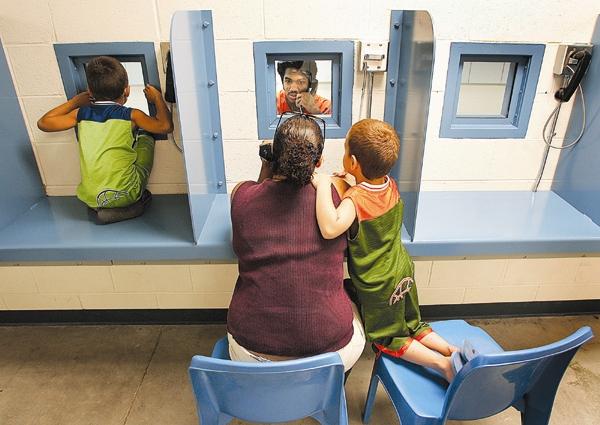
First, you’re advised to arrive about 15-20 minutes early. This will give you enough time to fill out the necessary paperwork and go through the numerous security clearances as you enter the grounds. Arriving early is especially important your first time visiting someone in jail. The paperwork process is less exhausting on subsequent visits.
If you arrive late, your time with your loved one will simply be cut short. (On the other hand, arriving too early will cause an inconvenience to prison staff. Arriving 20 minutes early should give you more than enough time to do what you need to do.)
As mentioned, you should expect to have your person and vehicle searched once you enter the parking lot, and again as you enter the actual facility. You’ll likely be asked to remove any jewelry you may be wearing, your belt, and anything in your pockets.
Generally, you’re allowed to keep the following items with you during your visit:
- Money for vending machine snacks
- Diaper and bottle if you bring a child
Most other objects, including your keys, must be stored in a locker that will be provided.
There are, of course, objects you shouldn’t bring, as well, such as:
- Medication of any sort
- Cigarettes or tobacco-related products
- Anything that can be considered or used as a weapon
- Illicit substances or materials
You’ll likely be able to leave medication or tobacco products in your car, but it is probably best to just leave them at home. As for illegal instruments or substances, since you’ll be consenting to a lawful search upon entering the grounds, possession of any of the sort may ultimately lead to criminal charges against you.
The smoother your intake process goes, the quicker you’ll be able to see your loved one. Do everything you can on your end to make sure this happens.
During Inmate Visitation
Once you’re finally allowed to actually see your friend or family member, it’s important to remember you’re not at home or the mall. For security reasons, a number of seemingly innocuous actions are not tolerated while visiting a prisoner and may be cause for visitation to end prematurely.
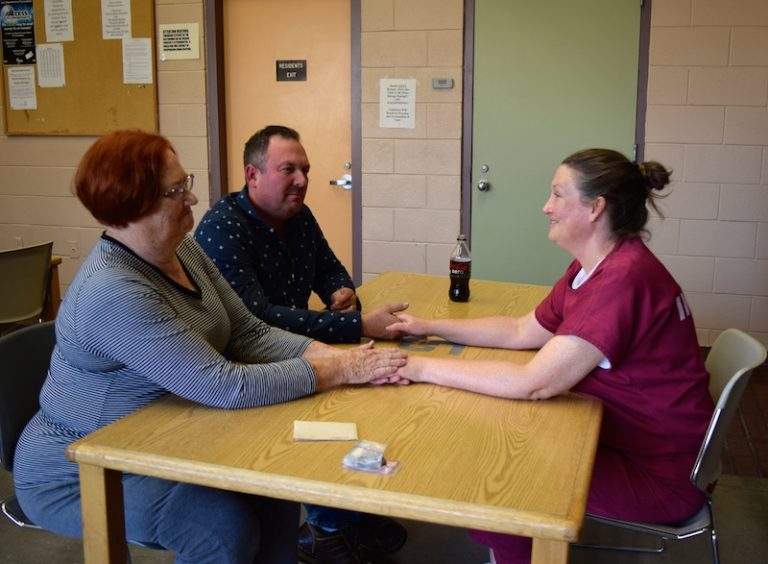
You should always maintain a professional demeanor during your visit. Speak in a lower tone of voice, stay calm, and be considerate of other visitors, inmates, and staff members. Boisterous laughter or anything of the sort will almost always cause staff to end your visit early.
You’ll be relegated to a specific table where your visit will take place, and you must not move from your assigned seat throughout the visitation. In general, you’ll be sat across from your loved one with a visible amount of physical space between the two of you. Any excess movement or fidgeting will arouse a guard’s suspicion, and generally will not be tolerated.
You’ll be allowed to give a hug, handshake, or kiss “hello” and “goodbye” at the beginning and end of your visit, but nothing more. Again, a pat on the shoulder may seem innocuous to you as a friendly visitor with nothing to hide, but, for security reasons, such fraternizing is not allowed.
Inmate visitation lasts anywhere from 15-30 minutes. Once time is up, you’ll be allowed to say a quick goodbye and will be escorted to your locker to gather your belongings, then will be brought out of the facility.
The amount of inmate visitations you’re allowed to make depend on a variety of factors, such as an institute’s policy, your loved one’s behavior, and the administration’s discretion. However, federal law dictates that inmates must have at least four hours of total visitation time per month. Depending on your relationship to the inmate, you may be able to see them more often than you had initially hoped.
As mentioned, visiting an incarcerated loved one for the first time can be a nerve-wracking experience.
But, as long as you understand exactly what to expect before and during your visit, you’ll be able to focus on the positive aspects of getting some much-needed facetime with your imprisoned friend or family member.
And, as long as you follow the regulations of the institution, you should be welcomed back as much as lawfully allowed.
Have you ever visited a loved one in jail or prison? What else should first-time visitors expect that we may have missed? What advice can you give those who are nervous about entering a prison facility as a guest?
We love hearing from our readers. Let us know if you have anything to add!
Support trustworthy, independent journalism that sheds light on the darkest corners of our justice system through journalism — fighting misinformation and leading to real change.
The Long Journey to Visit a Family Member in Prison
Remote prison towns and strict visitation policies make it hard to stay in touch..

The first time Jodi Calkins visited her son at the federal prison in Seagoville, Texas, the journey took her about 10 hours. From her home in Elkins, West Virginia, she drove three hours to the Pittsburgh International Airport, took a three-hour plane ride to the Dallas Love Field airport, then drove another hour in a rental car to a hotel near Dallas.
After driving an additional hour to the prison, FCI Seagoville, the next day, Calkins was turned away. Her son, Michael James, waited anxiously for hours.
When the mother and son talked on the phone later that night, Jodi explained that she had been blocked from entering the prison because she was wearing a dress with thin, zigzagging black and khaki stripes. Khaki was one of the prohibited colors for visitors at FCI Seagoville.
“Most of these prisons are out in the middle of nowhere, so you can't run out and get a new outfit,” she said. “You learn really quick to fill your trunk with clothing.”

Jodi Calkins at her home in Elkins, West Virginia, in December. The decorations on the wall include framed artwork of the former record label of her son, who is at FCI Seagoville in Texas.
The majority of prisons across the country are located far from the city centers many prisoners—and their families—call home. More than 63 percent of people in state prisons are locked up over 100 miles from their families, a 2015 report from the Prison Policy Initiative found. Black and Latino people make up a disproportionate share of the prison population, but many prison towns are majority white.
Nearly 200 people responded to a Marshall Project callout sharing the routes they travel to visit incarcerated family members. In interviews, many of them said they didn’t have the time, money, childcare or car to make the journey to these facilities as often as they would like. Others said they could not afford to visit at all.
Studies have shown that in-person visits can help families on the outside and their incarcerated loved ones. More frequent visits during incarceration can also reduce the risk that prisoners will re-offend once they are released. But many respondents told us that visitation is an often stressful and sometimes humiliating process for families.
“I would have to psych myself up to go to visitation because it was so emotionally and physically draining,” said Calkins, who visited her son and her son’s father in separate prisons for decades.
Jodi Calkins’s journey
1,250 miles 10 hours

Pittsburgh International Airport
Calkins drove three hours from her home in Elkins, W.V. to Pittsburgh International Airport. She then flew to Dallas, where she rented a car.
Elkins, W.V.
Dallas Love Field Airport
FCI Seagoville
Driving to the prison took an additional hour.

Love Field Airport

Prison construction exploded during the 1980s and 1990s, bringing with it a promise of economic revitalization. All of the 40 new state prisons built in New York state between 1982 and 2010, for example, were located in rural areas, according to the Vera Institute of Justice .
"The rural prison boom in the United States really coincided with the farm crisis and the loss of manufacturing in rural America," said Tracy Huling, founder of the Prison Public Memory Project, which studies the history of rural prison towns. "Siting prisons was an apparent quick fix. The land was cheaper, and people either wanted them because they were so desperate for anything to keep their communities from collapsing, or it was easier to overcome opposition in a small place, with fewer people and fewer connections to power."
Most prison towns still haven’t been lifted out of poverty, Huling said.
There is also a racial dimension to the geography of prisons. “You have prisons, which lock up black and brown people, in predominantly white rural communities,” Huling said. “These areas have had little exposure to black and brown people outside of the law enforcement arena."
California State Prison Solano opened in 1984 in the rural town of Vacaville, halfway between San Francisco and Sacramento. It was the first new prison constructed in California in two decades.
Every two months, Romanethia Porter visits her husband at the Solano state prison, nearly 500 miles from her home in Riverside, California. If she leaves around 9 a.m., the Amtrak from San Bernardino usually gets her to Sacramento by 8 p.m.
Porter spends the night with her daughter, then takes an Uber to the prison the next morning. A round trip Amtrak ticket costs her about $106, and the Uber is $30 each way. If she took public transportation from Sacramento to the prison, it would take her more than twice as long.
Romanethia Porter’s journey
455 miles 12 hours

Porter takes Amtrak from Riverside, Calif., to Sacramento, a nearly 11-hour trip. She takes an Uber from there to the prison.
State Prison
Los Angeles

The expensive and time-consuming visits are made all the more stressful by the visitation process, which can be unpredictable. "There's a problem if you hold your loved one’s hand,” she said. “If it gets too crowded, they want to cancel the visit."
Because Porter travels more than 250 miles to visit her husband, California Department of Corrections and Rehabilitation policy entitles her to a full six-hour visit. But she said her time with her husband is sometimes cut short nonetheless.
Porter said she sometimes feels out of place in Vacaville, a majority white former agricultural hub now home to a high-end strip mall. She and other African American and Latino visitors sometimes feel disrespected by the corrections staff and by the town's white residents, she said. "It does bother some of the ladies I talk to, the treatment we receive. We’re not inmates."
Most prisons are not accessible by public transportation, making visits especially difficult for those who cannot drive. It’s common for families to share rides with each other or to organize carpools in Facebook groups and online forums.
Before 1988, there was no way to get to Plainfield Correctional Facility in Indiana if you didn't have a car. Cecelia Whitfield started visiting that same year.
Whitfield would drive from Indianapolis to visit a family friend who was incarcerated there. Soon, she started giving rides to other families who lived in the city. “When the families started asking if they could ride with us, I asked them, ‘Doesn’t the state offer transportation?’” she remembered. They said no.
Whitfield would also give rides to families when she visited her son, James Lamont Whitfield, in state prison. By 1990, she said she had put 100,000 miles on her minivan, which held five or six people. That year, she borrowed money from her mortgage and bought a bus to hold more passengers.
Thirty years later, James has been released, but the carpool is still running. Now, it’s expanded into a statewide rideshare service called Use What You’ve Got Prison Ministry that partners with the Department of Correction to offer low-cost rides to economically disadvantaged state residents visiting their loved ones. Whitfield said the demand has slowed down in recent years as state prisons have introduced video calls, but she still sees the value of in-person contact. "The healing touch is much more personal," she said.
Several states, including New Jersey and Florida, have laws requiring corrections departments to "make every effort" to consider the distance from families "whenever possible." And under a provision of the First Step Act, federal prisoners must now be moved within 500 miles of their families.
In most states, however, where prisoners are assigned comes down to other factors, such as security levels, sentence length and the availability of programming, such as drug treatment.
Even in states that consider proximity, transfers are common and travel times can quickly grow from minutes to hours. That's what happened to Denise Rock when her husband was transferred to the Desoto Correctional Institution in Arcadia, Florida, two and a half hours from her home. Before the transfer, he was just 45 minutes away.
Rock continues to visit every weekend, sometimes staying the night in a nearby campground, and said she plans to continue to do so indefinitely. His sentence, for second-degree murder, is 100 years.
"I have seen the positive effects of my presence there,” she said. “Being able to visit keeps him grounded in the real world."
Denise Rock’s journey
116 miles 2.5 hours

Correctional
Institution
Rock drives two and a half hours from her home to visit her husband at Desoto Correctional Institution.

Rock drives at night so she can get to the prison as early as possible. People start lining up along the side of the road leading up to the prison at midnight, she said, because of how long the check-in process takes. By the time the doors to the prison open at 8 a.m., the line of cars can sometimes stretch for a half-mile.
On the weekend of Thanksgiving, Rock arrived at the prison gates at 3:30 a.m. She was the eighth person in line for visitation.
Between 9:10 a.m. when her husband arrived, and 3 p.m., when visitation closed, they played games, walked around together and used the visitation room’s limited food offerings to cook a holiday meal. Rock made her husband "stuffing" from biscuit bread in the microwave. For dessert, they had a tiramisu prepared with cream cheese, creamer, sandwich cookies, hot cocoa and instant coffee.
They shared food with other visitors and their incarcerated family members, some of whom they’ve gotten to know over the years. Despite Desoto holding nearly 1,500 inmates, Rock said she sees the same 50 or 60 families every week.
"I know people who travel many more hours than I do," she said. "I'm one of the lucky ones.”
Our reporting has real impact on the criminal justice system

Our journalism establishes facts, exposes failures and examines solutions for a criminal justice system in crisis. If you believe in what we do, become a member today.
Beatrix Lockwood Twitter Email has reported on criminal justice issues including families of the incarcerated, prison food, and electronic monitoring. She uses social media and engagement reporting to include more community voices in stories.
Nicole Lewis Twitter Email is the engagement editor for The Marshall Project, leading the organization’s strategic efforts to deepen reporting that reaches communities most affected by the criminal legal system.
Stay up to date on our reporting and analysis.
An official website of the United States government
Here’s how you know
Official websites use .gov A .gov website belongs to an official government organization in the United States.
Secure .gov websites use HTTPS A lock ( Lock Locked padlock icon ) or https:// means you’ve safely connected to the .gov website. Share sensitive information only on official, secure websites.

How to look up prisoners and prison records
You can search for prisoners and prison records based on when and where someone was incarcerated. Find out how to look up federal, state, or local prison records.
Look up state and local prison records
For state and local prison records, contact the state's department of corrections .
Look up federal prison records from 1870 to present
Recent federal prison records (1982 - present), locate or learn about an inmate.
Use the Federal Bureau of Prisons (BOP) inmate locator to find out when a prisoner is or was expected to be released.
To learn more details about an inmate, find out how to submit a Freedom of Information Act (FOIA) request to BOP.
Get a copy of your own prison records
If you are looking for your own prison records, complete and submit Form DOJ-361 along with a FOIA request . This form helps BOP confirm your identity so your private prison records are not wrongfully disclosed.
Federal prison records 1870 - 1981
Find prisoner records prior to 1982 from the National Archives and Records Administration (NARA). To learn more about finding BOP records, contact NARA .
NARA also has indexes of inmates once held at Alcatraz, Leavenworth, and other federal prisons . Search by name for former inmates at each location to see if they served time there.
You may be able to order copies of prisoners' records through NARA if they are available. Include the following information about the inmate in your request:
- Name (including middle name or initial)
- Date of birth or approximate age at the time of incarceration
- Approximate dates in prison
LAST UPDATED: January 31, 2024
Have a question?
Ask a real person any government-related question for free. They will get you the answer or let you know where to find it.
Who Can Visit Someone Incarcerated in Federal Prison?

- by David Straughan
When a friend or relative is in prison, you may want to see them in person. It’s not impossible, or even terribly difficult, to do so. But only certain people can visit. And the chance to visit an incarcerated person in federal prison requires preparation.
Which family members can visit a person in federal prison?
In most cases, family members can visit loved ones in prison. This is not limited to immediate or “blood” relatives either. The Bureau of Prisons (BOP) includes stepfamily members, foster relatives and others as “family members” that can visit as well.
The official list of approved family members from the BOP includes the following:
- Mothers
- Fathers
- Step-parents
- Foster parents
- Grandparents
If you don’t fall into any of these categories, you may still be able to visit. But you will have to qualify under another category instead of “family member.”
Which non-family members can visit a person in prison?
The BOP also allows non-family to visit people in prison as well. These visitors can include anyone from friends to government or church representatives.
Typically, the BOP does not limit visitors who can meet with prisoners for more formal reasons. Examples of this might include lawyers or employers. But prisons will have limits for friends and other non-family members.
Friends and other non-family members must be on a list that is limited to 10 possible visitors at any given time. People in prison can add people to or remove people from that list at any time. But that process may take time as well.
The BOP’s list of non-family members that can visit include the following:
- No more than 10 friends or associates
- Foreign officials
- Members of religious groups
- Members of civic groups
- Former and prospective employers
- Parole advisors

How can you be approved for a visit?
Before you can visit your loved one in prison, the BOP must approve of your visit first. That’s true whether you’re a family member, a friend, an attorney, or anyone else. Fortunately, that approval process is fairly simple. We break it down into five steps:
- The prisoner receives a Visitor Information Form when they arrive at a new facility.
- After filling out the form, the prisoner sends a copy to each potential visitor by mail.
- The potential visitor fills out their portion of the form and returns it to the prisoner.
- The BOP may request more information on the potential visitor.
- The BOP makes a decision and notifies the prisoner.
Once you complete this process and get approved, you can plan your visit. To make sure it goes smoothly, you’ll want to schedule the visit with the facility. You’ll also want to review guidance on what to wear and how to behave.
The Takeaway:
Most people can visit their loved ones in prison. Depending on if you’re a family member or not, certain rules will apply. To make sure your visit goes smoothly, you should get approved, schedule and prepare for your visit ahead of time.

- Prison Resources
- Prison Rights
- Prison Visits
Social Share
How do you become a prison informant.

Forgot password?
Already Have An Account? Go For LogIn
Reset YOUR PASSWORD
Submit a Resource
- City & County Jails
- State Prisons
- Federal Bureau of Prisons (BOP)
- US Immigration and Customs Enforcement (ICE)
- US Bureau of Indian Affairs (BIA)
- US Military Prisons and Jails (MIL)
- US Enemy Combatant High Value Detainees (HVD)
- FIND AN INMATE
Should Children Visit Incarcerated Parents? How Can They Make a Visit?
Posted 4/11/2022 by Mark Miclette Inmate & Family Issues

America has an epidemic of parents in prison. Prisoners have nearly 1.5 million minor children , and nearly half of all prisoners are parents.
Incarceration can make the bond between parents and children tenuous. But there are ways a child can visit their parent and maintain their bond. You just need to know a few things in order to help a child.
Why should children visit their parents, and what rights do incarcerated parents have to see their children? What policies affect visitation? How can you create a smooth visit for a child?
Answer these questions and you can help a child remain in touch with their parent in no time. Here is your quick guide.
Legal Rights for Visitation
Nearly all incarcerated parents have the right to visitation with their children. It is usually in a child's best interest to maintain contact with both of their parents, even if one or both of them is in jail. Parents can offer their children love, affirmation, and support as they get older.
However, courts do not give incarcerated parents the automatic right to visit their children. An inmate parent needs to prove that they had an ongoing and positive parent-child relationship prior to their incarceration. They need to prove that visits would be convenient for the child and not impede their development.
Courts will deny parents who abused their children and/or committed violent felonies visitation rights. When a child turns 18, they may be able to initiate contact with their parent. But an abusive parent cannot contact a child prior to their adulthood, even through a letter or a phone call.
Prison Visitation Policies
Though most parents have the right to see their children, prisons have the right to impose policies on visitation. Some prisons adopt an immediate family policy. This means that prisoners can only receive guests from their immediate families.
Married prisoners can see their spouses, children, and parents. But unmarried people may not be able to meet with children they had with a partner they did not marry. Prisoners may not be able to receive visits from adopted children or stepchildren.
Most prisons require inmates to fill out forms, giving information to the prison officials about their loved ones. The prisons may then run background checks on the visitors.
Children under the age of 16 can only visit a parent in prison with a chaperone. The chaperone can be their parent, guardian, or a trusted family member like a grandparent.
To visit someone in prison, a child must go through metal detectors and have their bags checked by prison officials. They may need to wait in line for a long period of time.
A child may be able to bring a small gift, but they may need prior approval for it. Most prisons allow incarcerated people to accept books or toiletries, though the contents of the books need approval. A child may need to ship the gift to their parent instead of presenting it to them in person.
Creating a Smooth Visit
Despite the difficulties of visiting someone a jail, a child can have a smooth and pleasant visit with their parent. The key is to make preparations well in advance. Read a guide on how to prepare for visitation and follow a few different steps.
Explain What Will Happen
A child can find a correctional facility intimidating and confusing. You should sit down with the child and explain to them what will happen step by step. Tell them why prison visitation policies are in place and how the visit will end.
You can roleplay how the visit will go so a child has a clearer sense of what will happen. You can also use storybooks and visual aids so they can picture the visit in their mind.
A child may not be eager to visit their parent for some reason. You should work with the child to schedule the visit for a time that is convenient to them. You can also help them develop an activity they can do with their parent.
Visit the Prison Yourself
You or another family member should visit the inmate prior to the child's visit. This will help you understand how to visit someone in prison and set a child's expectations. You should talk to the inmate parent about how the visit should go.
You may also want to visit a prison official in person and work out the security procedure with them. This is a good idea if the child has special needs and may need accommodations for the procedure.
Keep the Child Updated on Their Parent's Life
Visits are just one way that a child and parent can stay connected. The two should write letters to each other on a regular basis. A child can type their letters if they struggle with penmanship or holding a pen.
For their parent's birthday or during the holiday season, a child can send them a care package. They can send them money for the commissary, or they can give their parent snacks or shampoo. Make sure to follow all instructions for sending prisoners a care package .
Planning Visits Between Children and Incarcerated Parents
Children should remain connected with incarcerated parents so they receive support and learn about life lessons. But parents must receive their visitation rights from a court, and visitors must follow restrictive visitation policies. Children must receive approval to visit the prison and they must go through security checks.
But you can help. Tell a child what will happen and let them remain in contact with their parent throughout their childhood. Make visits one component of a strong relationship.
Start the visitation process today. Jail Exchange provides tools for finding inmates. Find an inmate here .
2024 total solar eclipse is Monday: What to know less than a week out
Editor's note: An updated cloud forecast for the April 2024 total solar eclipse is in. Read the latest eclipse forecast and news as of Wednesday, April 3 .
The 2024 total solar eclipse is now less than one week away, and forecasters are getting a clearer picture of what the skies will look like. It's not all good news for people who want to see the spectacle.
On Monday afternoon, April 8, a total eclipse of the sun will cross over a dozen states as it traverses from Texas to Maine. Millions of people are expected to travel to see it.
The full total solar eclipse experience will plunge people along a narrow path into darkness midday, but people outside the path of totality can still use eclipse glasses (maybe free eclipse glasses ) to see the moon pass in front of the sun — if it's not blocked by clouds.
Meanwhile, those planning to order glasses online may be rapidly running out of time to do so in order to have them delivered on time .
Here's the latest weather forecast for the day of the eclipse:
A grim forecast for Texas
Unfortunately, the weather is looking iffy for folks in some places, especially Southern areas: The cloud cover forecast "shows fairly high probability of clouds in Texas up through the Mississippi Valley," wrote meteorologist Matt Lanza on his blog The Eyewall.
The National Weather Service in Dallas said there's only a dismal 15% chance for favorable viewing conditions in Dallas on April 8. "The outlook for favorable viewing conditions continues to deteriorate as the event approaches," the weather service said.
Indeed, the computer models that meteorologists use to forecast weather show a grim forecast for Texas: "The operational runs of both the GFS and European models have, consistently, shown nearly 100 percent cloud cover across much of the state during the early afternoon hours on Monday," said Eric Berger, a Houston-based meteorologist on the blog Space City Weather .
Another forecaster, Marc Chenard of the Weather Prediction Center, confirmed the gloomy forecast to USA TODAY: "Cloud cover is most likely in Texas, Oklahoma and Arkansas," he said. In fact, "varying degrees of cloudiness" are likely all the way to the Ohio Valley, he said.
Could there be storms on Monday?
Monday may not only be cloudy in some areas, it could also be stormy, forecasters said: "At this time, specifics about hazardous weather are unknown," the Weather Prediction Center said. "However, rain and thunderstorms do appear possible in and near the path of totality in Texas, southeast Oklahoma, and Arkansas."
Where is the best chance for clear skies for the total eclipse?
For the total eclipse, the best chances for clear conditions are in New England and upstate New York, Chenard told USA TODAY.
"If I’m picking a place right now, it’s probably like Watertown, New York," Lanza said.
The National Weather Service in Buffalo is also bullish on the chances for good weather, with a caveat: The forecast continues to suggest dry weather for Monday with high pressure over the eastern Great Lakes and Ohio Valley, "however it is FAR too early to forecast cloud cover with any confidence or reliability," the weather service wrote in its forecast discussion.
Ironically, the prediction of clouds in Texas and clear skies in the Northeast are the opposite of historical trends for cloud cover .
Where is the cloud forecast best for the partial eclipse?
There will also be ample opportunities for folks to view the partial eclipse: "The best locations for viewing can be the Southwest and the East, especially east of the Appalachians," AccuWeather lead long-range forecaster Paul Pastelok said. "Cities like El Paso, Albuquerque, Philadelphia, Washington D.C., New York City and Raleigh should all have great views."
Although not in the path of totality, regions in the Southwest also look to have ideal weather.
"The area from West Texas to southern Arizona should also have favorable viewing conditions," Pastelok added. "These areas will be close to the path of totality with the least amount of cloud cover anticipated."
Order eclipse glasses online now to have them delivered on time
If you're buying your specs through American Paper Optics, the nation's largest supplier of eclipse glasses, the company makes it easy for you with a countdown at the top of its website for how much longer you have to procrastinate. As of Tuesday morning, customers have little more than three days to make their purchase and take advantage of the company's express shipping across the country.
That's about the same amount of time allotted to Walmart+ online shoppers , as well as Prime members looking for reputable glasses on Amazon .
Many eclipse websites like GreatAmericanEclipse.com and NationalEclipse.com also sell a variety of eyewear products, along with plenty of other gadgets — but double check that estimated delivery date before checking out.
How do I watch the 2024 solar eclipse, if clouds don't block it?
There are a few ways of watching the eclipse:
- Get the full experience in person : If you're in a narrow band of U.S. land that spans from Texas to Maine, you could see the moon block the sun and its shadow cast a night-like darkness over Earth for a few minutes. You could briefly be able to look up without eye protection and see the moon block the sun.
- Watch from outside the path of totality : Much of the U.S. could get a partial view of the eclipse that isn't nearly as impressive as being in the path of totality. Earth won't be plunged into complete darkness and you'll have to wear protective eyewear to see the moon partially block the sun.
- Watch a livestream : Check back on April 8 for a video feed from the path of totality. It's not the same as being there in person, but hey, at least you won't have to sit in traffic .
What time is the solar eclipse on April 8?
The eclipse will begin in Texas at 1:27 p.m. CDT and end in Maine at 3:35 p.m. EDT, but the exact time of the eclipse varies by where you are in its path.
Here are the major cities in each state where you can expect to experience totality (note that the included times do not account for when the partial eclipse begins and ends):
- Dallas, Texas: 1:40-1:44 p.m. CDT
- Idabel, Oklahoma: 1:45-1:49 p.m. CDT
- Little Rock, Arkansas: 1:51-1:54 p.m. CDT
- Poplar Bluff, Missouri: 1:56-2:00 p.m. CDT
- Paducah, Kentucky: 2-2:02 p.m. CDT
- Carbondale, Illinois: 1:59-2:03 p.m. CDT
- Evansville, Indiana: 2:02-2:05 p.m. CDT
- Cleveland, Ohio: 3:13-3:17 p.m. EDT
- Erie, Pennsylvania: 3:16-3:20 p.m. EDT
- Buffalo, New York: 3:18-3:22 p.m. EDT
- Burlington, Vermont: 3:26-3:29 p.m. EDT
- Lancaster, New Hampshire: 3:27-3:30 p.m. EDT
- Caribou, Maine: 3:32-3:34 p.m. EDT
Will clouds really ruin the eclipse?
Clouds are just part of weather, and as noted in the latest forecast, it's likely that some of the millions of people in the path of totality for April's total eclipse will have to endure overcast skies that will impact the experience .
But determining how clouds would change your view depends on the types of clouds – and which expert you ask. Some advise eclipse watchers to not worry about the skies, others say an overcast sky can ruin the experience.
Before last year's annular solar eclipse, National Weather Service meteorologist Tim Daldrup told Oregon Public Radio that if clouds are in the forecast, you should hope for the "right kind of clouds."
“If we want to see it, we’ll want the higher-level clouds,” Daldrup told OPR. “Those tend to be the more feathery cirrus clouds that can still be seen through. They might obstruct the eclipse but you can still see it.”
Cirrus clouds would be in contrast to some of the more eclipse-unfriendly clouds, such as a thick deck of lower-level stratus or cumulus clouds that would likely completely block the sun.
New York inmates say a prison lockdown for the eclipse violates religious freedom
Inmates at a New York prison who are being prevented from witnessing next week's total solar eclipse have filed a lawsuit against the state corrections department, claiming that the decision violates their religious freedoms.
The celestial phenomenon , which has not passed over New York since 1925 and will not be seen again in the state until 2079, "is a significant religious event for people of many different faith backgrounds," according to the complaint, which was filed Friday in federal court in upstate New York.
However, New York corrections officials put a lockdown in place at its facilities for April 8 , the day the eclipse will pass over a long stretch of North America , including New York, as the moon blots out the sun. Among them is the Woodbourne Correctional Facility, the prison in Woodbourne where six men of varying religious faiths jointly sued the corrections department over the policy.
The plaintiffs – a Baptist, a Muslim, a Seventh-Day Adventist, two practitioners of Santeria and an atheist – are asking a judge to order the corrections department to immediately rescind the lockdown memo and provide eclipse glasses to all inmates who wish to view the eclipse, as it did when a partial eclipse was visible in 2017 in New York.
"This should not be controversial and was previously allowed during the last solar eclipse viewable in New York State," the lawsuit stated, arguing that the lockdown is unconstitutional.
'Devil' comet to make an appearance this month
As if a solar eclipse weren't enough, observers on April 8 may also get a glimpse of a rare "horned" celestial show , a dazzlingly bright comet with a scary name.
A comet designated 12P/Pons-Brooks got the much more interesting name “devil comet” when it had an outburst, a large ejection of dust and gases, in July 2023.
On the day of the Great American Eclipse , the devil comet may become visible to the unaided eye, astronomers say.
Amateur and professional observers in the Northern Hemisphere will get a unique opportunity to view the comet, which is renowned for its periodic eruptions of gas and dust.
Parents of Michigan school shooter Ethan Crumbley both sentenced to 10-15 years for involuntary manslaughter
PONTIAC, Mich. — The first parents to ever be charged , then convicted, in their child’s mass shooting at a U.S. school were both sentenced Tuesday to 10 to 15 years in prison after they faced the victims' families at a sentencing hearing in a Michigan courtroom.
James Crumbley, 47, and his wife, Jennifer, 46, were sentenced one after another by Circuit Court Judge Cheryl Matthews as they appeared together for the first time since they attended joint hearings before their landmark trials were separated last fall. Their son, Ethan, now 17, pleaded guilty as an adult to the 2021 shooting at Oxford High School in suburban Detroit and was sentenced to life in prison.
Matthews' sentencing decision was in line with what Oakland County prosecutors had asked for after both parents were found guilty on four counts of involuntary manslaughter, one for each of the students their son killed.
Matthews told the Crumbleys that the jury convictions were "not about poor parenting" but about how they repeatedly ignored warning signs that a "reasonable person" would have seen.
"These convictions confirm repeated acts that could have halted an oncoming runaway train," she said.
The couple will get credit for time served in an Oakland County jail since their arrests in the wake of the shooting on Nov. 30, 2021. The pair sat apart at the defense table with their lawyers beside them as the families of the four students who were killed asked before sentencing for the maximum terms to be imposed.
"When you texted, 'Ethan don't do it,' I was texting, 'Madisyn I love you, please call mom,'" Nicole Beausoleil, the mother of shooting victim Madisyn Baldwin, 17, told the Crumbleys. "When you found out about the lives your son took that day, I was still waiting for my daughter in the parking lot.
"The lack of compassion you've shown is outright disgusting," she added through tears.
Jill Soave, the mother of another slain student, Justin Shilling, 17, said the parents' inaction on the day of the shooting "failed their son and failed us all."
Justin's father, Craig Shilling, said he was troubled by Jennifer Crumbley's testimony during her trial in which she said she would not have done anything differently, even today.
"The blood of our children is on your hands, too," Craig Shilling said.
James Crumbley wore an orange jumpsuit and headphones to help with his hearing, and Jennifer Crumbley wore a gray-and-white jumpsuit. He did not look at his wife, while she glanced in his direction.
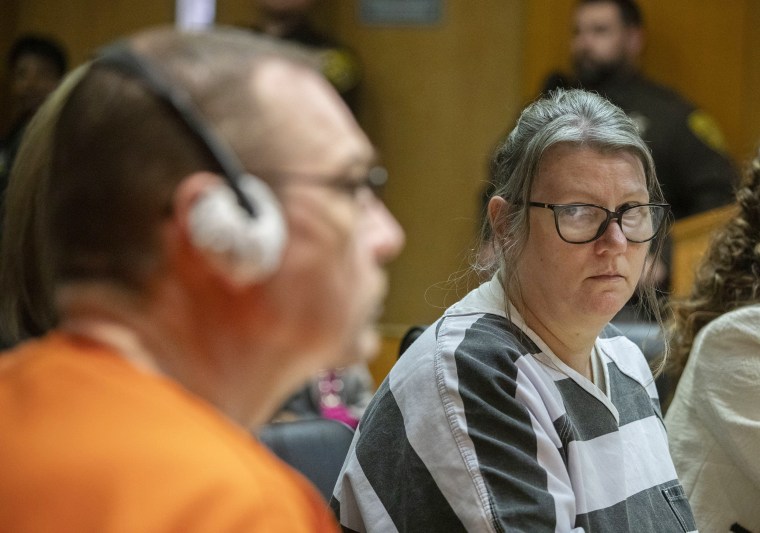
In Michigan, prosecutors said, felonies that rise out of the same event must run concurrently, so the most Matthews could have imposed is 15 years in total. And while prosecutors wanted the parents to receive sentences that exceeded the advisory guideline range, Matthews had the ultimate discretion, weighing factors such as past criminal behavior and the circumstances of their crimes.
Before she was sentenced, Jennifer Crumbley told the court that she felt "deep remorse, regret and grief" about the shooting, but she also deflected some of the blame onto school officials and took offense to the prosecution's strategy portraying her as a neglectful mother .
"We were good parents," Crumbley said. "We were the average family. We weren't perfect, but we loved our son and each other tremendously."
James Crumbley also addressed the court, explaining to the judge that he did not know beforehand about his son's planned attack on his school and telling the victims' families directly that he would have acted differently on the day of the shooting.
"Please note that I am truly sorry for your loss as a result of what my son did," he said. "I cannot express how much I wish I had known what was going on with him or what was going to happen."
Matthews said during Tuesday's sentencing that the family would not be housed together and that the state Corrections Department has indicated James and Ethan Crumbley specifically will not be in the same facility given their relationship. Ethan is being held in a state prison 17 miles from Oxford High School. Jennifer Crumbley would be sent to the state's only women's prison.
James and Jennifer Crumbley have not been able to communicate as part of a no contact order since their arrests.
In both parents' cases, prosecutors wrote that their "gross negligence changed an entire community forever."
They both could have prevented the shooting with "tragically simple actions," prosecutors wrote, adding that they "failed to take any action when presented with the gravest of dangers."

Legal experts had suggested James Crumbley could have faced a harsher sentence than his wife after prosecutors said he made threats in jail.
During his trial, Matthews restricted his communication to only his lawyer and clergy.
The sentencing memo for James Crumbley referred to allegations that he made threats against the prosecutor and said that "his jail calls show a total lack of remorse" and that "he blames everyone but himself."
The memo details the expletive-ridden threats he is alleged to have directly addressed to the prosecutor on multiple recorded jail calls. In one call before the trial, he said, "Karen McDonald, you're going down," according to prosecutors. In other calls, he threatened retribution, they said.
James Crumbley’s lawyer, Mariell Lehman, wrote in court documents that the calls did not include threats to physically harm the prosecutor but that he expressed his desire to ensure that McDonald is not able to continue practicing law as a result of her actions in the case.
"It is clear Mr. Crumbley is venting to loved ones about his frustrations related to the lack of investigation done by the prosecution prior to authorizing charges," Lehman wrote, saying her client is understandably angry at his situation.
The prosecution's memo also says James Crumbley asserted his innocence in a pre-sentence report, indicating a lack of remorse.
"I feel horrible for what happened and would do anything to be able to go back in time and change it! But I can't. And I had nothing to do with what happened," he wrote, according to the prosecution memo. "I don't know why my son did what he did. HE is the only one who knows."
Lehman has not said whether she plans to appeal James Crumbley's verdict, while a lawyer for Jennifer Crumbley, Shannon Smith, has written that she will.
Two separate trials
James Crumbley did not take the stand during his trial. His wife testified that she placed the responsibility of securing the 9 mm semiautomatic handgun used in the shooting on her husband.
Asked whether she would have done anything differently, Jennifer Crumbley told jurors, "I don't think I'm a failure as a parent."
Prosecutors argued that she knew of her son's deteriorating mental health and social isolation and that he had access to a gun but that she cared more about her hobbies and carrying on an extramarital affair than about being present at home.
Her defense lawyer attempted to portray her as a caring mother, albeit one who did not know her son was capable of such violence — suggesting instead that his school failed to fully inform her of his troubles and that her husband was responsible for the weapon.
Smith continued to defend her client in her sentencing memo.
"Criticizing Mrs. Crumbley for being 'rarely home' is a sexist and misogynistic attack on a mother," Smith wrote.
In a pre-sentence report, Jennifer Crumbley said she has the hindsight now to know she would have handled things differently.
"With the information I have now, of course my answer would be hugely different," she said. "There are so many things that I would change if I could go back in time."
Both her and her husband's trials centered on the day of the shooting.
A day after Thanksgiving, prosecutors said, James Crumbley bought their son the handgun, while Jennifer Crumbley took him to a gun range that weekend.
On Tuesday, a teacher said she had found a note on Ethan's desk with a drawing of a gun and a person who had been shot, along with messages including: "The thoughts won't stop. Help me."
That discovery prompted the school to summon the parents for a meeting, but school officials testified that they declined to bring him home because they had to go back to work.
The officials also said that if the parents had informed them that their son had access to a gun, they would have been more authoritative to ensure immediate safety.
Ethan would go on to commit the school shooting later that afternoon, killing Baldwin; Shilling; Tate Myre, 16; and Hana St. Juliana, 14.
Victims' families want accountability
In the aftermath of the trials, the victims' families have demanded further accountability. They are seeking changes to governmental immunity laws that protect schools from being sued and want to see a requirement for independent reviews after any mass shooting.
Oakland County prosecutors have said they do not plan to charge anyone else in connection with the massacre.
Buck Myre, the father of Tate Myre, said during Tuesday's sentencing that families still want a government-led investigation.
"It's time to drive real change from this tragedy," he told the judge.
Later, James Crumbley stood and addressed Buck Myre directly when he was given the chance to speak.
"It is time that we all know the truth," he said. "I, too, want the truth, because you have not had it."
Selina Guevara and Maggie Vespa reported from Pontiac and Erik Ortiz from New York.
Selina Guevara is an NBC News associate producer, based in Chicago.
NBC News Correspondent
Erik Ortiz is a senior reporter for NBC News Digital focusing on racial injustice and social inequality.
- Skip to main content
- Keyboard shortcuts for audio player
Here are the 42 questions on the juror questionnaire in Trump's hush money case

Ximena Bustillo

Former President Donald Trump speaks to the press at Manhattan criminal court after a hearing on Feb. 15. Angela Weiss/AFP via Getty Images hide caption
Former President Donald Trump speaks to the press at Manhattan criminal court after a hearing on Feb. 15.
The search for 18 fair and impartial jurors will begin next week in former President Donald Trump's first criminal trial.
Trump faces a 34-count felony indictment alleging that he falsified New York business records in order to conceal damaging information to influence the 2016 presidential election. Monday kicks off jury selection for the trial that is expected to last about six weeks — even as Trump campaigns to be president once again. Trump has pleaded not guilty to the charges.
In total, 42 questions will be used to select 12 jurors and six alternates for the first-ever criminal trial featuring a former or sitting president. And this will be Trump's first appearance in a trial since winning enough delegates to receive the GOP nomination.
Read the juror questionnaire:
Still, jurors will not be asked for whom they have voted or will vote, nor will lawyers question them about their political affiliations or campaign contributions. New York Judge Juan Merchan, who is overseeing the trial, believes those views will be made clear through other questions.
Jurors will be asked to identify the online media, news and social media programs they use, podcasts they listen to and if they have ever considered themselves a supporter or a member of any of six white supremacist and extremist groups — including the QAnon movement, Proud Boys and Antifa.

See where the big Trump cases stand in the months leading to the election
They will also be asked about their business and political relationships with the former president and New York business mogul. Lawyers will ask if prospective jurors, a relative or a close friend ever worked for any company or organization that is owned or run by Trump or anyone in his family. And they will be asked if they have ever attended a rally or campaign event for Trump, volunteered for his campaign or been a part of any "anti-Trump" efforts.
These have all been questions similarly asked in Trump's previous jury trials in Manhattan.

Trump's Trials
Here's what you need to know about the new york hush money case, correction april 9, 2024.
A previous version of this story said Trump pleaded guilty to the 34-count felony indictment. He has pleaded not guilty.
- Juan Merchan
- criminal trial
- Donald Trump
- Stormy Daniels

COMMENTS
June 22, 2016. Father Michael Van Sloun. 0. To visit the imprisoned is a corporal work of mercy. Jesus mentioned it specifically when he said, "For I was . . . in prison and you visited me" (Mt 25:35, 36). Jesus has mercy for "the least," those despised by others. Convicts rank high among "the least.". For the general public, when a ...
The fifth Corporal Work of Mercy is "Visit the Imprisoned.". This work of mercy is important, and often neglected. When I was in college, I had the privilege of being involved in the Legion of Mary, a Catholic lay apostolate that began in Ireland, that involves a commitment of two hours of apostolic work done each week, always with a ...
Karen Imholte shares a little of her story as an educator in the prison system, and a little bit of a story of one of her students. With a little tough love, Karen (and his Grandmother) empowered him to take a college level course that changed his life. Describe a time someone challenged you with tough love.
Find the prison's website. Many prisons now have websites. On the website, you can find important information for planning your trip. Look for the website so that you can find out how to schedule a visit. You will also want information about what you can bring. 3. Call to ask about restrictions.
Philip Kosloski Blogs January 11, 2016. The next corporal work of mercy includes two separate acts: "ransoming the captive" and "visiting the imprisoned.". For the purposes of this article ...
According to a 2012 Pew Forum Survey of U.S. prison chaplains, prisons are a "bustle of religious activity.". Seventy-four percent say attempts by inmates to convert or proselytize other ...
General Visiting Information. Make sure your visit will be a success by carefully following these four steps. Locate the inmate. Discover or confirm the whereabouts of the inmate you would like to visit. Be Approved. Before you can visit you must be placed on the inmate's approved visiting list. Be Prepared.
Jesus visited him in this prison, so to speak, by seeing him, not as he was, but as he could and should be: a free and joyful child of God. So, too, should we see and help those who are imprisoned by a variety of walls. We should see them, not as they are, but for what they should and can be: free and joyful children of God.
To Visit the Imprisoned. It's a corporal work of mercy that, so often in my life, I've opted to sort of skirt around. I'm a mother, after all, and this means vigilance when it comes to my family. And so the thought of visiting the imprisoned has seemed something to avoid. And yet, lately, God has very directly been tapping me.
Like visiting, you might start by writing to someone from your social network, or you can use a program like the Death Row Support Project to get connected. Before writing, visit the prison or jail's website to read their rules and procedures, and also check out Mary Catherine Johnson's tip sheet for letter writing. Although Johnson writes ...
Matthew 25:36 (H2) "I was in prison and you came to visit me." - Matthew 25:36. In this passage, Jesus emphasizes the importance of visiting those who are imprisoned. He teaches that when we care for those who are suffering, we are directly serving Him. By visiting the incarcerated, we are fulfilling a crucial aspect of our Christian duty and ...
State departments of corrections. Contact your state department of corrections about state and local prisons and prisoners. Learn how to locate prisoners and get prison records. Find out how to send money or visit someone in prison. Learn how to file a complaint about a prison.
Visit the Imprisoned. In this year's Lenten reflection series, seven sisters offer their personal stories and insights on each of the Corporal Works of Mercy and how acts of mercy can have a profound impact on the lives of our sisters and brothers. Accompanying these reflections are line drawings by Sister Mary Clare Agnew, a contemporary of ...
Jesus' powerful words in the Gospel of Matthew form the basis for the traditional list of the works of mercy. When it comes to meeting physical needs, the Compendium to the Catechism of the Catholic Church lists the following actions as the corporal works of mercy: Feed the hungry. Give drink to the thirsty. Clothe the naked. Shelter the ...
Give yourself an extra 15-20 minutes to fill out paperwork. Be prepared to be searched before being admitted into the visiting room. Searches may include a pat down by an officer of the same gender and a pass through a metal detector. All visitors must be searched, including children. Before bringing children, consider visiting alone first so ...
To be granted a conjugal visit or extended family visit, generally, both the inmate and visitors must submit applications. Common rules include: requiring that the prisoner seeking such visits have a clean prison record of good behavior and no violence; prohibiting visitation for prisoners incarcerated for child abuse or domestic violence, and
Alexia Wulff 19 February 2023. With over 100,000 prisons and jails around the globe, historic jail cells and prison museums have become a huge draw for tourists, and the US is no different - the states has over a dozen historic prisons to discover. From Alcatraz Island's remote location off the shores of San Francisco to Eastern State ...
Visit the imprisoned. As with "burying the dead," visiting the imprisoned might seem, at first glance, a work of mercy that's out of reach for most families. How is that supposed to work with young children? Let's back up and think about aspects of our society that can create isolation, loneliness and even a feeling of imprisonment.
You don't want something silly like the way you're dressed to be the reason your loved one doesn't get to see you. Arriving to the Prison for Inmate Visitation. Once you arrive at the prison, you'll be subjected to a number of procedures before you're actually allowed to see your loved one. These procedures are all in the name of ...
Rock drives at night so she can get to the prison as early as possible. People start lining up along the side of the road leading up to the prison at midnight, she said, because of how long the check-in process takes. By the time the doors to the prison open at 8 a.m., the line of cars can sometimes stretch for a half-mile.
Search by name for former inmates at each location to see if they served time there. You may be able to order copies of prisoners' records through NARA if they are available. Include the following information about the inmate in your request: Name (including middle name or initial) Date of birth or approximate age at the time of incarceration.
Friends and other non-family members must be on a list that is limited to 10 possible visitors at any given time. People in prison can add people to or remove people from that list at any time. But that process may take time as well. The BOP's list of non-family members that can visit include the following: Image courtesy of FooTToo at iStock ...
Children under the age of 16 can only visit a parent in prison with a chaperone. The chaperone can be their parent, guardian, or a trusted family member like a grandparent. ... Tell them why prison visitation policies are in place and how the visit will end. You can roleplay how the visit will go so a child has a clearer sense of what will ...
Earth won't be plunged into complete darkness and you'll have to wear protective eyewear to see the moon partially block the sun. Watch a livestream : Check back on April 8 for a video feed from ...
PONTIAC, Mich. — The first parents to ever be charged, then convicted, in their child's mass shooting at a U.S. school were both sentenced Tuesday to 10 to 15 years in prison after they faced ...
Jurors will be asked to identify the the news and social media programs they use, podcasts they listen to and if they have supported or been a member of white supremacist and extremist groups.
The imprisoned Russian nationalist who played a leading role in bringing down the Malaysian airlines flight MH17 wants to join the front line in Ukraine.. The wife of Igor 'Strelkov' Girkin, a ...